Located on a mountaintop above the El Tajo gorge, the village of Ronda is truly a white gem in the bluest skies over Andalusia.

You’ll find her in the Málaga province somewhere between her grand and famous Andalusian sisters. Yet, this little precious gem full of ancient beauty shimmers at least as mesmerizingly as the big shots.
- Help Me Ronda
- Mañana is Good Enough For Me
- Serranía de Ronda
- Ronda's History in a Nutshell
- Famous Visitors
- Big Tour of Little Ronda
- Jardines de Cuenca
- Puente Viejo and Arco de Felipe V
- Fuente de los Ocho Caños
- Baños Árabes
- Palacio de Salvatierra and Murallas de la Cijara
- Iglesia Santa María y del Espíritu Santo
- Plaza Duquesa de Parcent
- Ayuntamiento de Ronda
- Convento de Clarisas de Santa Isabel de los Ángeles and Convento de la Caridad o Hermanas de la Cruz
- Iglesia de Santa María La Mayor
- Palacio de Mondragón
- Casa del Gigante
- Museo Unicaja Joaquín Peinado
- Museo Lara
- Casa Don Bosco
- La Casa del Rey Moro
- Mirador de los viajeros románticos and Convento de Santo Domingo
- Mirador de Aldehuela
- Puente Nuevo and El Tajo de Ronda
- Paseo de Kazunori Yamahuchi
- Bullring of the Royal Cavalry of Ronda
- Alameda del Tajo and Paseo De Los Ingleses
- Plaza del Socorro
- Practical Information
- Map
- Pinnable Pictures
Help Me Ronda
Ronda didn’t have it easy with me. I had slept really badly the night before, waking up from weird dreams. On the bus, I was annoyed by a rude bus driver – you might remember from this post that I have some sort of lifelong vendetta with bus drivers. Spain’s bus drivers were not able to improve this image.
Then, as I arrived at Ronda’s bus station at the newer part of town, I was quite disenchanted.
That was it?
The same pedestrian streets at identical commercial parts of town with the obligatory chain stores? Good that I had booked for only one night.
As I call at the little guesthouse Casa Duende del Tajo*, a friendly lady opens the door and leads me down two steep flights of stairs to a small, very austere room. A bed and a built-in closet. I need to cross the hallway to get to the shared bathroom. Hence, nothing fancy at all.
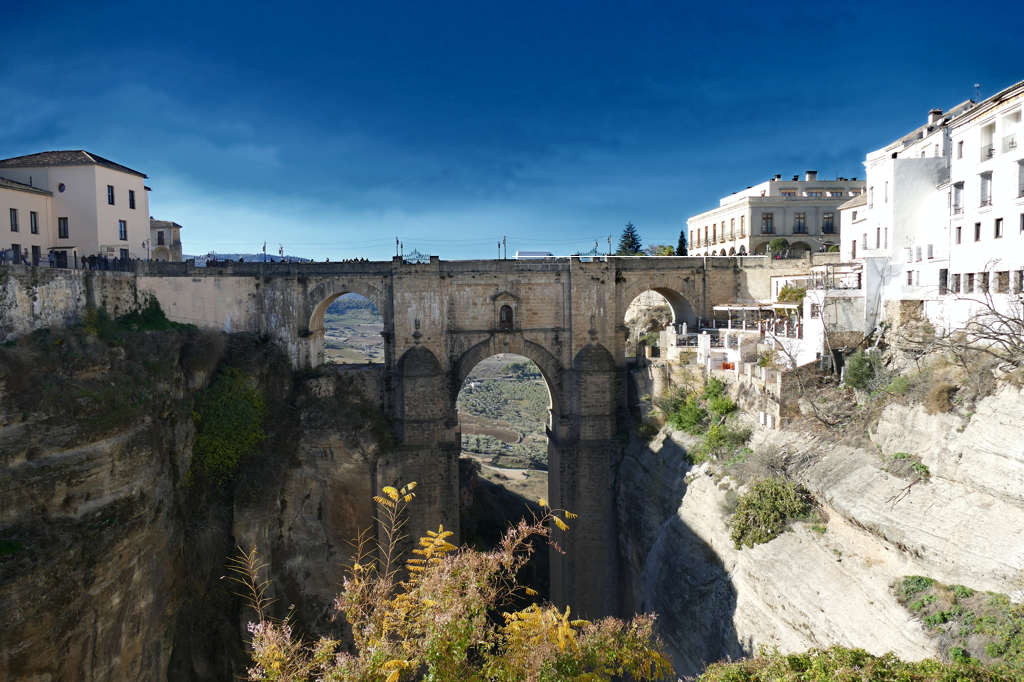
But there is this window and as I pull the curtain open, for a split second, I feel like looking at some romanticist painting. Out there, practically at my fingertips, is Ronda’s most iconic landmark, the Puente Nuevo. It’s already dark so that this truly impressive structure is bathed in a golden yellow light.
Everyone comes to Ronda to see the Puente Nuevo and I can look at it from a distance of maybe 50 meters as often and as long as I want.
Ronda touches my heart and welcomes me with open arms.
Mañana is Good Enough For Me
I wake up quite a few times that night. Every time I wake up, it takes a moment to familiarize myself with the pitch-dark room. Then I look outside the small window across from my bed. I see the illuminated Puente Nuevo. What a dreamy and soothing sight!
With a bright smile, I close my eyes and snuggle up between the pillows’n’sheets.
Life is good.
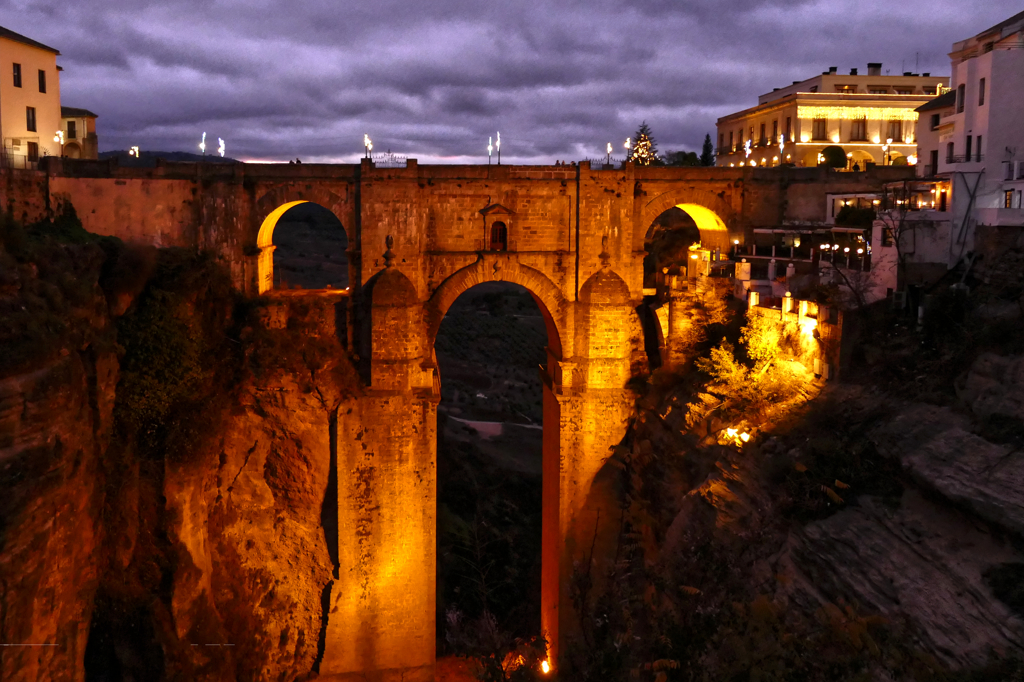
The next morning, I first take a couple of pictures of the bridge in the pale morning light. Then I hit the road in search of breakfast.
At this early hour, Ronda’s streets are still empty. Only some essential workers – isn’t it nice how the pandemic broadened our vocabulary?! – are placing tables and chairs outside the restaurants or pulling up the shutters of their stores.

Across from the church Nuestra Señora de la Merced Ronda is the small one-star hotel Colón. They also have a cozy café. As I enter, almost all of the dark wooden tables are occupied. I’m lucky and get a small table next to the bar. I order my new favorite breakfast, tostadas with olive oil and ground tomato – a delicacy. The friendly waitress brings me my order and places a basket full of complimentary spreads on the table.
I read the labels. Everything is pork-based. Well, you only live once, and my cardiologist isn’t in sight. Hence I tear one of the small containers open and place a generous blob of some truly delicious but also really greasy potted pork on one of my tostadas.
Life is even better.
Serranía de Ronda
Before I take you to Ronda’s most amazing places, let me tell you a little bit about its location and history.
In the national park Serranía de Ronda, you will find spectacular mountain panoramas and pristine nature. As the Serranía offers a wide variety of landscapes and some cultural highlights, everybody – whether interested in nature, sports, or culture – will find something to enjoy.
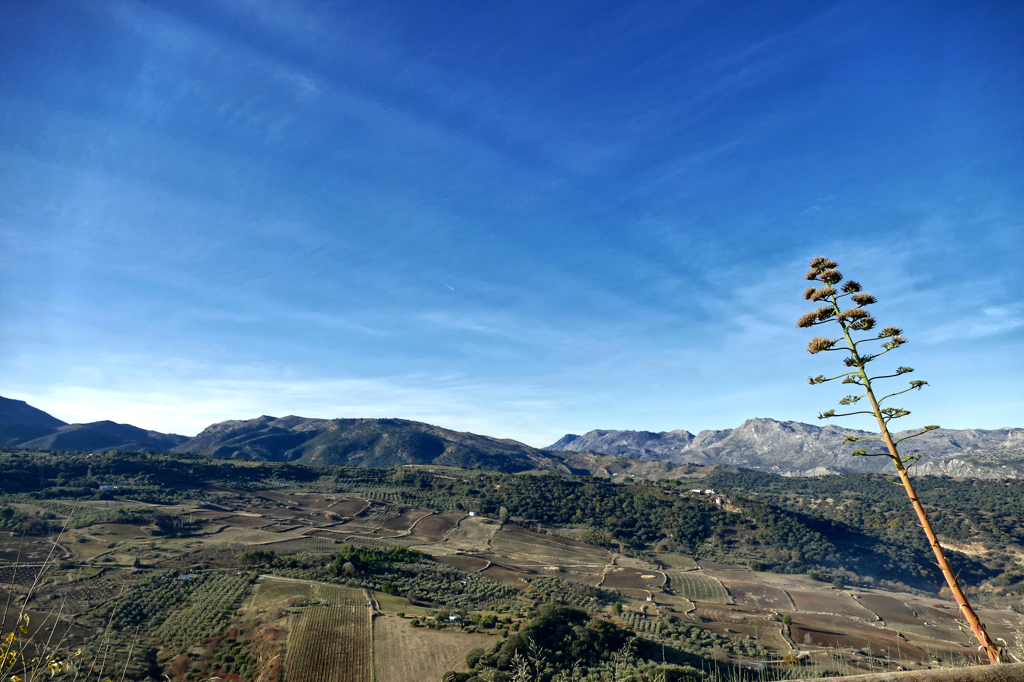
The Serranía de Ronda begins just a few kilometers behind the coast of Málaga. Yet, Ronda is more than 100 kilometers inland from Andalusia’s same-named capital on the Mediterranean. Also, it is located at an altitude of over 750 meters above sea level.
It won’t surprise you that Ronda is mainly famous for its location. The once Moorish old town is located on an all-around steep rock plateau. This historic part of town is separated from the new one by the legendary deep gorge Tajo de Ronda. It was formed by the Río Guadalevín.
Ronda’s History in a Nutshell
Arunda – the Romans gave today’s Ronda its first name.
In 549, Byzantines occupied the south of the Iberian Peninsula. Soon, the Visigoths evicted them and destroyed the old city.
Then, at the beginning of the 8th century, Moors from North Africa invaded the Iberian Peninsula. In 713, Abd al-Aziz, the governor of Al-Andalus, occupied Arunda. On the ruins of the Roman fortifications, he commissioned a palace.
When the Caliphate of Córdoba split into rival kingdoms in the 11th century, Abú-Nur came to power in Ronda. During this time, the capital was renamed Madinat Ronda. Also, the city’s defenses were extended.
In 1147, the Almohads conquered Al-Andalus, hence, Andalusia, after they had already defeated the whole of Northwest Africa.
Reconquista
In 1212, there was a decisive battle between the Christian armies and the Almohads at Las Navas de Tolosa where the Moors were defeated. Consequently, only the Nasrid Kingdom of Granada remained as Andalusia’s last Islamic empire.
Ronda, as one of the westernmost cities of this empire, became an important border town and trading center. However, in 1485, the Christians conquered Ronda among a number of other Moorish cities.
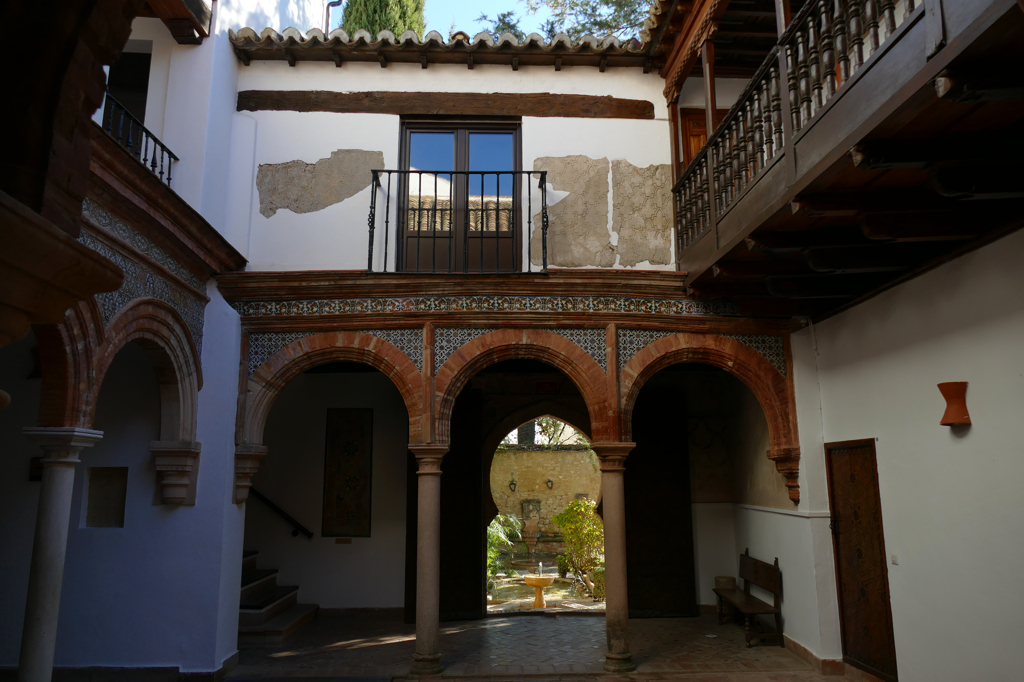
The lands’n’buildings were distributed among the Catholic conquerors. After an uprising, the last Muslims were banished in 1570. The last remnants of their presence in Ronda are the Baños Árabes, the Puente Viejo bridge, and buildings like for instance the Palacio de Mondragón.
Famous Visitors
In the 19th and 20th centuries, famous artists from all over the world visited Ronda. Some of them like the German poet Rainer Maria Rilke and writer Ernest Hemingway spent actually long periods of time in the city. In Hemingway’s novel Whom the Hour Strikes, a fascist is pushed from a square into a deep ravine in a small town. The tale tells an actual occurrence in Ronda during the Spanish Civil War.
At the age of 18, actor Orson Welles spent a summer in Ronda. The city- and in particular the bullfights – left a lifelong impression. After his death in 1985, his ashes were buried in a well on the Recreo San Cayetano estate on the outskirts of Ronda, according to his last will.
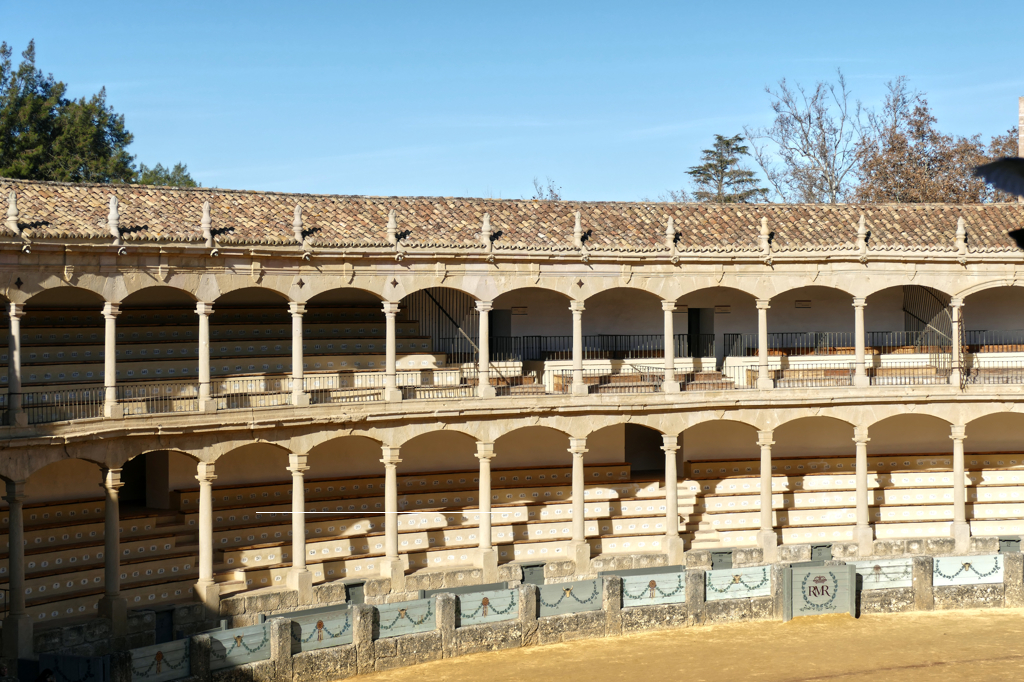
The actress Ava Gardner spent some time in Ronda after her divorce from Frank Sinatra in 1957.
In 1994, Ronda’s famous bullring was the backdrop of Madonna’s video Take A Bow.
Trivia:
Already French writer Prosper Mérimée set his novel Carmen in Ronda and the surrounding mountains. Only the composer Georges Bizet moved her to Seville.
However, as Francesco Rosi filmed the opera Carmen with Julia Migenes and Plácido Domingo in Ronda in 1984, he actually brought the plot back to its original place.
Big Tour of Little Ronda
So, you’re ready to follow the footsteps of Hemingway, Gardner, and Madonna – as well as about a quarter-million less famous annually visitors? The town can be visited in one day – mind you, many tourists are coming just on a day trip. Nevertheless, I would recommend at least two days. This way, you don’t only check off the most important landmarks from your list but can really immerse yourself in Ronda’s smalltown-vibe.
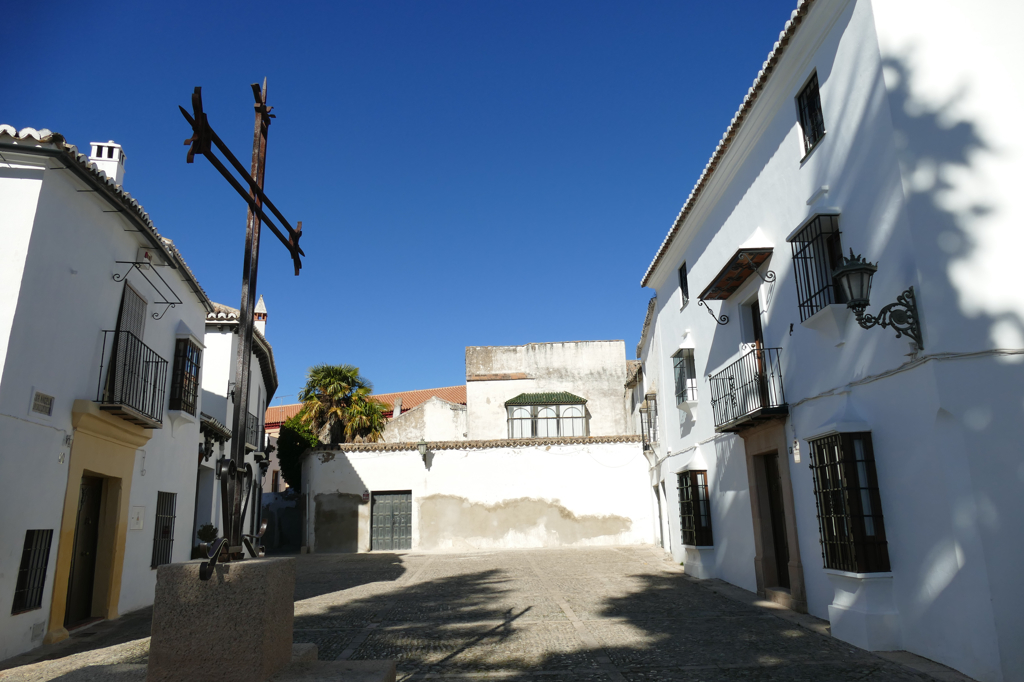
Either way, following my itinerary, you’ll get to see all the most important sights in one go. Eventually, you can still decide for yourself if that’s sufficient or if you need longer in certain spots.
Jardines de Cuenca
Although the Puente Nuevo is Ronda’s most iconic landmark, it makes sense to begin your tour on the other side of the Río Guadalevín. Also, this way, you get some of the best views of the bridge from the 18th century.
The so-called Cuenca Gardens are beautifully arranged in stepped terraces. They offer spectacular views of the Tajo all the way to the Puente Nuevo.
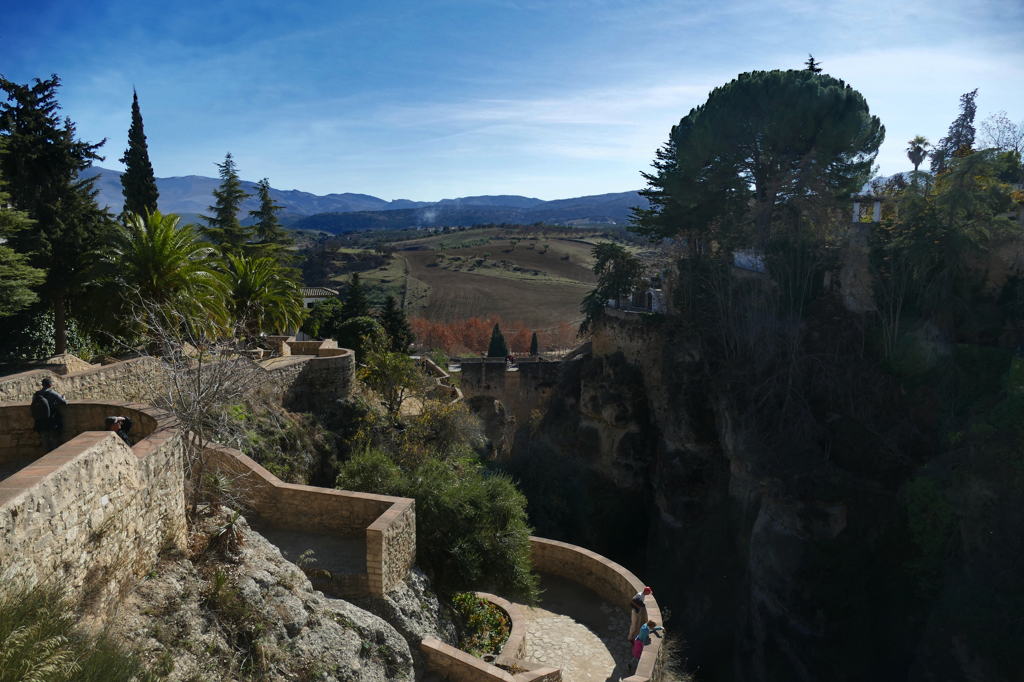
The garden is named after Cuenca, Ronda’s sister city. Although it lies about 600 kilometers east approximately halfway between Madrid and Valencia, the similarities between those two towns are obvious.
The views from the gardens over the canyon formed by the Río Guadalevín are just spectacular.
To get to the gardens, walk down the Calle Virgen de los Remedios and turn right into the Calle Escolleras. From here, you can stroll through the terraced gardens all the way down to the old bridge.
Important Notice:
Many of Ronda’s historic and iconic landmarks are very old, obviously. Sadly, most times, they are not barrier-free. There are man stairs – not only at the terraced gardens, but for instance also as you walk down from the Puente Viejo to the Baños Árabes. Actually, if you’re not light on your feet, exploring Ronda will be a challenge and partly even impossible.
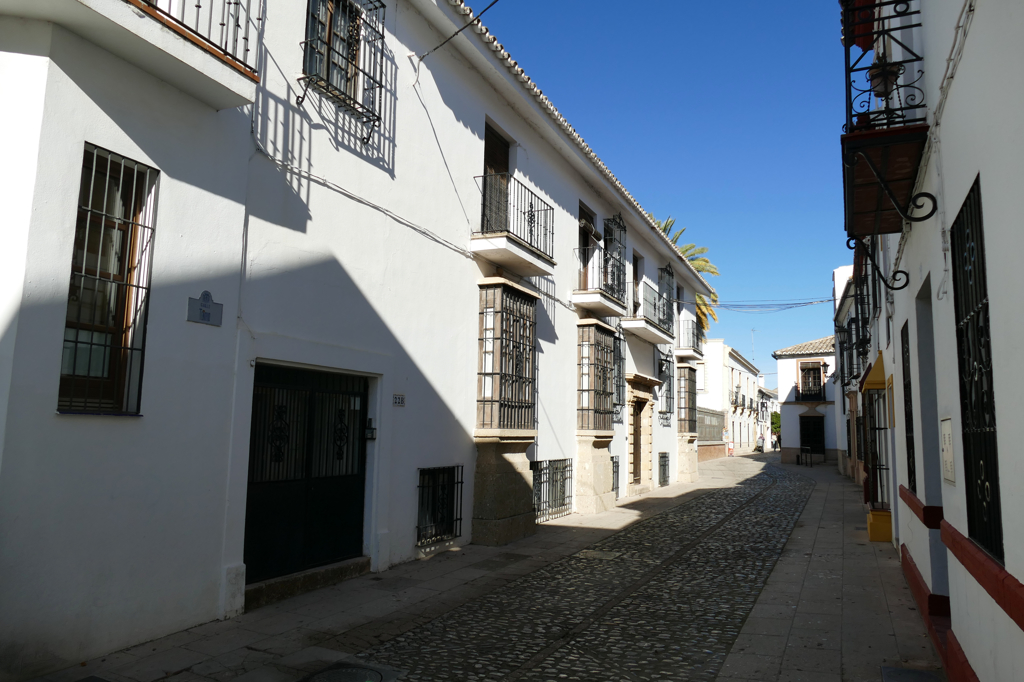
But even if you are a good walker, make sure to wear sensible shoes. You’ll do a lot of walking through cobblestone paved alleys and on uneven, dust-covered, and rocky ground.
Puente Viejo and Arco de Felipe V
Only since the construction of the New Bridge in the 18th century, this former Puente Nuevo became Puente Viejo, hence the old bridge. It was the entrance to the city during the Moorish era. A beautiful arch crowns its entrance. It was erected – you might have guessed so – during the reign of King Felipe V in 1742.
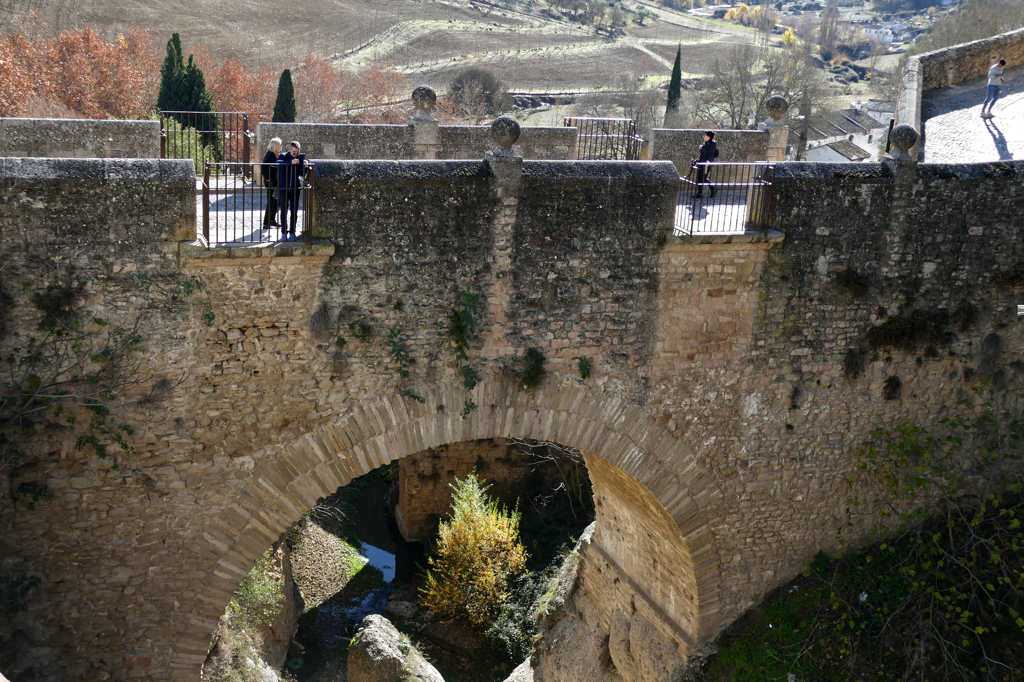
After the Reconquista, it remained destroyed and had to be urgently repaired. King Fernando II delinquents who were good craftsmen to reconstruct the bridge. However, a flood wrecked the bridge again in 1616.
Standing on the Puente Viejo, you can enjoy grand views of the city on one side and scenic vistas of the surrounding hills’n’fields on the other.
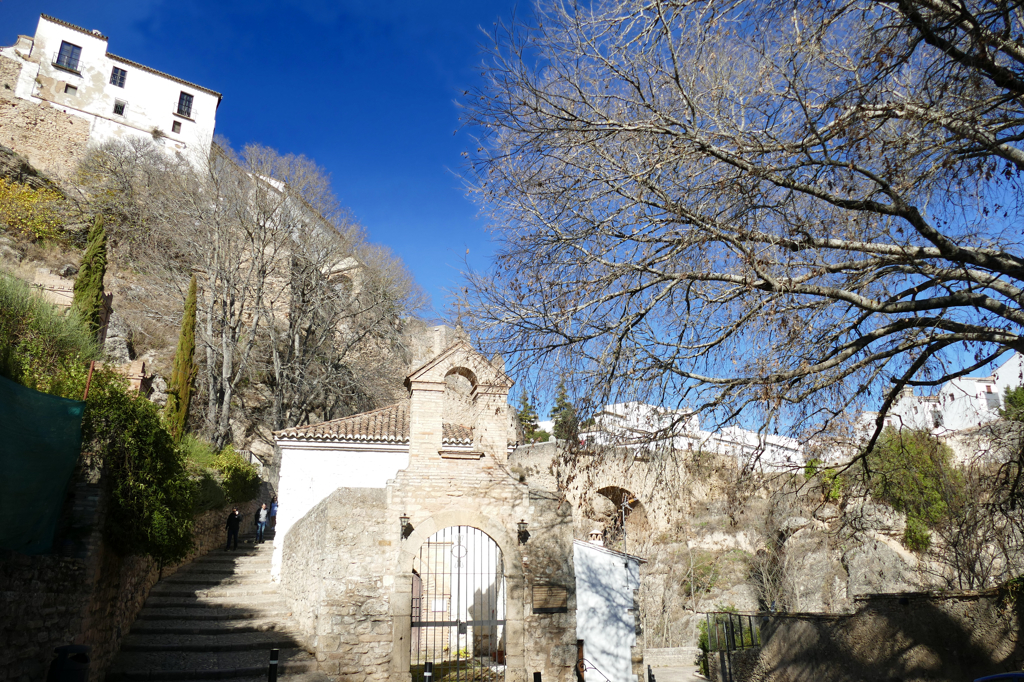
After the collapse of the first Puente Nuevo in 1741 – Ronda is not very lucky with its bridges, after all – there was a high need to enhance the entrance to the city from this side of town. Therefore, the broader Arco de Felipe V replaced the old Arab Gate.
Fuente de los Ocho Caños
Before you walk down the stairs from the old bridge towards the Arab Baths, walk a few steps in the opposite direction. There, in front of the church of Padre Jesús is the fountain of the Ocho Caños de Ronda.
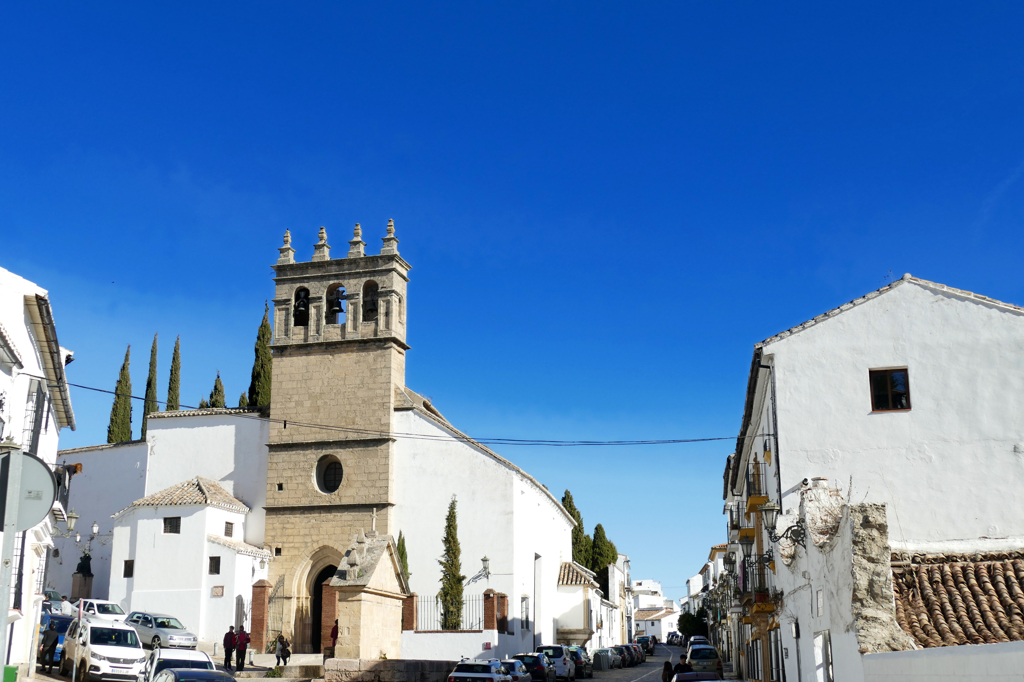
This beautiful public fountain dates back to the 18th century. It was built from stone and consists of two bodies. In one of them are eight taps that give the fountain its name. The rear, however, is just a trough.
Baños Árabes
The Barrio de San Miguel was Ronda’s Muslim medina. Here are the remnants of the Baños Árabes, the best-preserved Arab Baths in the entire Iberian Peninsula.

In the past, a wall with blind arches protected the complex. They collected the water in the nearby rivers and pumped it in an aqueduct on arches and columns with a waterwheel. From there it then reached the bathrooms.

You can visit the archeological site every day between 10 a.m. and 6 p.m. with a lunch break from 2 p.m. to 3 p.m. on Mondays, Saturdays, and Sundays.
The general admission fee is 3 €uros. However, the Bono 8 Monumentos, as well as the Bono Túristico, cover also the Baños Árabes. You’ll find details about these passes in the Cash, Cards, and Deals section below.
Palacio de Salvatierra and Murallas de la Cijara
Perched on a rocky plateau above the Río Guadalevín, the Muslim medina of Ronda, had to meet its defensive needs wherever the terrain was easier to access. Hence, the Walls of the Cijara.
Initially built from mud, they were fixed by stone masonry in the 14th century. Today, this beautiful walk leads you through the Cijara gate to the Old Bridge and Arab Baths.

As a matter of fact, these structures are made up of several old houses. Those formerly so-called Painted Houses were standing on the rocks of the Tagus and were one with the city wall. They belonged to Muslim citizens. However, in the Repartimiento of Ronda, a distribution carried out by the Catholic Monarchs after the conquest of the city in 1485, Don Vasco Martín de Salvatierra received this complex.
Also, since descendants of Don Vasco Martín de Salvatierra still live in a part of the palace, it is not open for touristy visits. However, as Madonna obtained a permit to shoot her the music video Take a Bow inside in 1994, you might consider that option. Otherwise, you can only see the striking façades.
Iglesia Santa María y del Espíritu Santo
As I was hiking from the Barrio de San Miguel uphill, I was quite intrigued by the sight of the Church of the Holy Spirit. With its dark, a bit rundown walls and the flock of birds wheeling around the roof, it had something mystical and even spooky to it.

Construction was carried out at the end of the 15th respectively beginning of the 16th centuries. It has the hybrid Gothic-Renaissance style which is characteristic of that era.
The façade is very simple. It is flanked by two large buttresses that are topped with pinnacles.
You get the best views of the church from the parking lot El Castillo on top of the former Castillo del Laurel. If you want to visit the inside, inquire if it’s open for touristy visits again.
Plaza Duquesa de Parcent
In the heart of Ronda’s historic part is the former Plaza Mayor, the main square. Today, it’s called Plaza Duquesa de Parcent. The city’s most significant buildings such as the City Hall), the Collegiate Church, El Castillo, and the convents of Santa Isabel and de la Caridad are grouped around the lush garden.
Ayuntamiento de Ronda
This above-mentioned town hall, located on the east side of the Plaza Duquesa de Parcent, was originally the headquarters of the Provincial Militia Barracks.
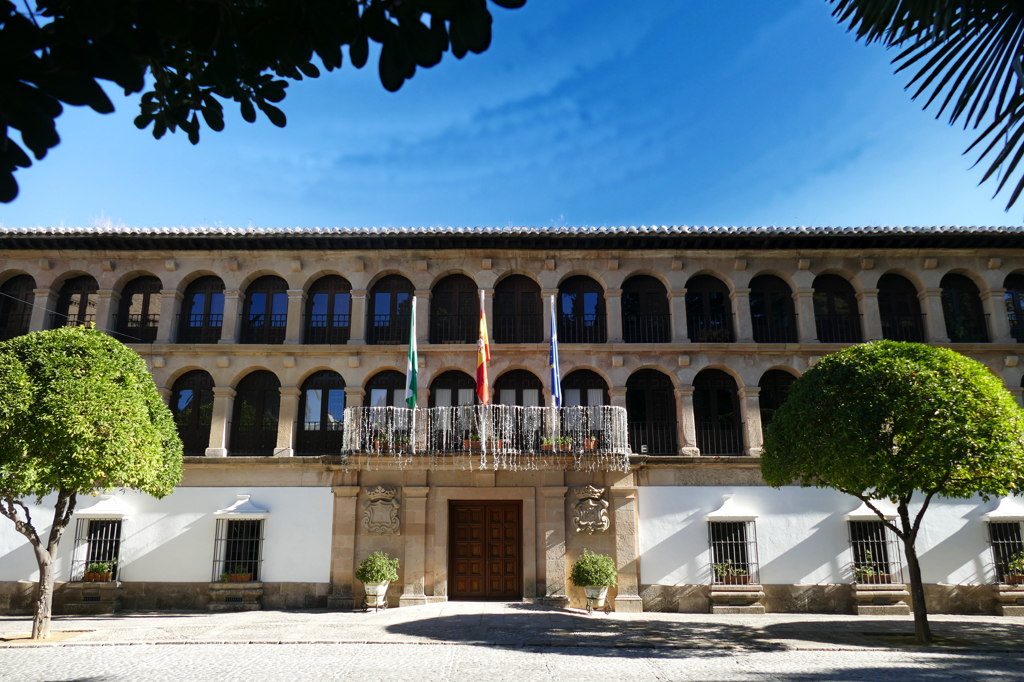
It was constructed in 1734 over what supposedly used to be Muslim shops in the 16th century.
The building has three floors. Overlapping arches make up the two upper ones. In contrast, the ground floor has only a few windows for interior lighting.
The Ayuntamiento de Ronda is an official governmental building and thusly not open to touristy visits.
Convento de Clarisas de Santa Isabel de los Ángeles and Convento de la Caridad o Hermanas de la Cruz
The convent of Clarisas de Santa Isabel de los Ángeles was built in the 16th century and eventually expanded. It stands on the western side of the Plaza Duquesa de Parcent. During the Spanish Civil War, it suffered significant damage and had to be restored. The convent’s most remarkable features are the church and a doorway made of stone
You can access the church through a small atrium over a stone doorway. Opening hours are from 9 a. m. to 12.30 p. m. and in the afternoon from 3.30 p. m. to 5.30 p. m. However, during the services, you should refrain from walking around and taking pictures.

Next to the convent of Clarisas de Santa Isabel de los Ángeles is the Convento de la Caridad o Hermanas de la Cruz on the northern side of the Plaza Duquesa de Parcent. This building from the 16th century has been used as a hermitage as well as a school building of various institutions. The Sisters of the Cross are known for their Christmas cakes’n’cookies that they are preparing following old recipes and selling through a wooden turnstile.
Iglesia de Santa María La Mayor
The most prominent building at the Plaza Duquesa de Parcent is probably the Iglesia de Santa María La Mayor. It was built shortly after the Christian Reconquista in 1486.
According to the different building stages spanning over more than two centuries, you’ll make out two distinct architectural styles on the church’s inside. Since it took forever to complete the building, it is now an eclectic mix of Moorish, Gothic, Renaissance, Baroque, and Mannerist styles – all mixed together.
In the entrance area are some valuable objects on display such as an image of the Virgin of Peace, the city’s patron saint, and some antique bronze bells.
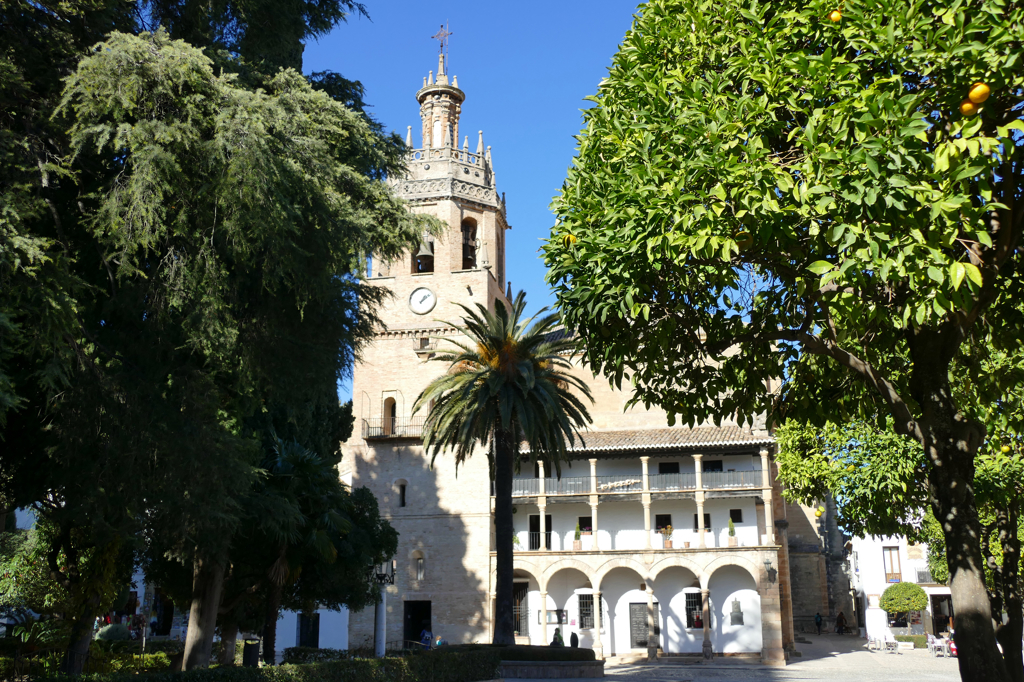
You can visit the church every day between 10 a. m. and 7 p. m. On Sundays, there is a lunch break from 12.30 p. m. to 2 p. m. The general admission fee is 4 €uros.
Palacio de Mondragón
Leaving the square through the Calle Manuel Montero between the two convent buildings, you’ll get to the Palacio de Mondragón.
The Benimeri King Abd al-Malik, son of the Sultan of Morocco Abul Hassan, lived in the Mudejar-Renaissance building from the 14th century.
After Abd al-Malik passed away, Ronda got under the hegemony of the Kingdom of Granada. The palace became the residence of the Nasrid governor.
As Catholic Monarchs conquered Ronda in 1485. They chose their palace as their residence during their stay in town. Eventually, Captain Melchor de Mondragón obtained the mansion that today houses the Archaeological Museum of Ronda.

The entrance courtyard stems from the 18th century. The so-called Mudéjar patio is from the 16th century. It is a mixture of Gothic, Renaissance, and Mudejar styles, obviously. From this patio, a horseshoe arch with a Mudejar door opens to the lush garden. The third courtyard is in the late Gothic style.
You can visit the Palace every day between 10 a.m. and 6 p.m. with a lunch break from 2 p.m. to 3 p.m. on Mondays and Saturdays.
The general admission fee is 3 €uros. However, the Bono 8 Monumentos, as well as the Bono Túristico, cover also the museum. You’ll find details about these passes in the Cash, Cards, and Deals section below.
Casa del Gigante
The Casa del Gigante de Ronda was built as a private home between the late 13th and early 14th centuries. It is one of the best-preserved buildings from the Nasrid era.
After Fernando II conquered Ronda, the palace passed into the possession of various Catholic Spaniards. In 1656, ancient tombs with inscriptions and Roman vessels were found inside the house.
After the Casa del Gigante had been a private residence in the 20th century, it was opened to the public in 2015 so that visitors can enjoy the beautiful architecture of Spain’s final Muslim era.
The mansion is open from Monday to Friday between 10 a.m. and 3 p.m. for a general admission fee of 4 €uros.
However, the Bono 8 Monumentos covers also the Casa del Gigante. You’ll find details about these passes in the Cash, Cards, and Deals section below.
Museo Unicaja Joaquín Peinado
Just across from the Casa del Gigante is the museum that celebrates Joaquín Peinado’s work. Already the venue – housed in the noble Moctezuma Palace – is full of beauty and history.
Since 2021, the hometown of Joaquín Ruiz-Peinado Vallejo is honoring the artist with a permanent exhibition of his cubist paintings. In addition, the collection also includes 49 works by Peinado’s famous friend and colleague Pablo Picasso.
Due to his political ideas, Peinado lived and worked in Paris during the years of the Spanish Civil War – just like Picasso and famous director Luis Buñuel, whom he befriended. After long stays in the Americas, he returned to Spain in 1969. In 1975, he died in Paris
The Museo Unicaja Joaquín Peinado is open from Monday to Friday between 10 a.m. and 5 p.m., Saturday only till 3 p.m.
The general admission fee is 4 €uros. However, the Bono 8 Monumentos covers also the museum. You’ll find details about these passes in the Cash, Cards, and Deals section below.
Museo Lara
It was thanks to the private initiative of Juan Antonio Lara Jurado, a businessman from Málaga, that Casa Palacio Museo Lara was opened in 1989 at the Casa Palacio de los Condes de las Conquistas.
Since the age of ten, Lara Jurado has been a collector. Today his collections of clocks, weapons, cameras, radios, gramophones, sewing machines, and carriages – to name just a….few, I guess – comprises about 2,000 objects. The passionate collector himself, now in his 80s, has a private residence above the museum.
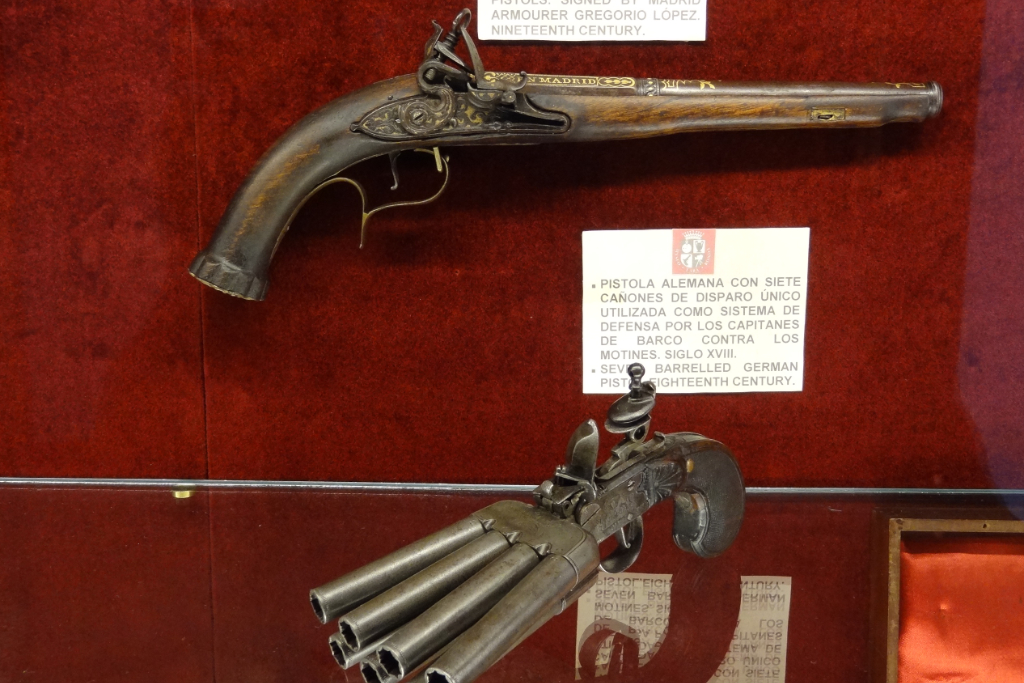
(Photo: Andras Vadas, Lara Museum-05, trimmed 3:2, CC BY-SA 3.0)
You can visit Lara’s cabinet of curiosities every day from 11 a.m. till 8 p.m. during the summer months between June and October. From November till May, the venue closes already at 7 p.m.
The general admission fee is 4 €uros. However, the Bono 8 Monumentos covers also the museum. You’ll find details about these passes in the Cash, Cards, and Deals section below.
Casa Don Bosco
The engineer Francisco Granadino Pérez and his wife Dolores Gómez Martínez commissioned local Santiago Sanguinetti to built this modernist mansion in the early 20th century. In their will, they transferred it to the Salesian Congregation as a ´shelter for elderly and sick priests of the order. Since Italian priest Saint John Bosco founded this Congregation, the manor bears his name.
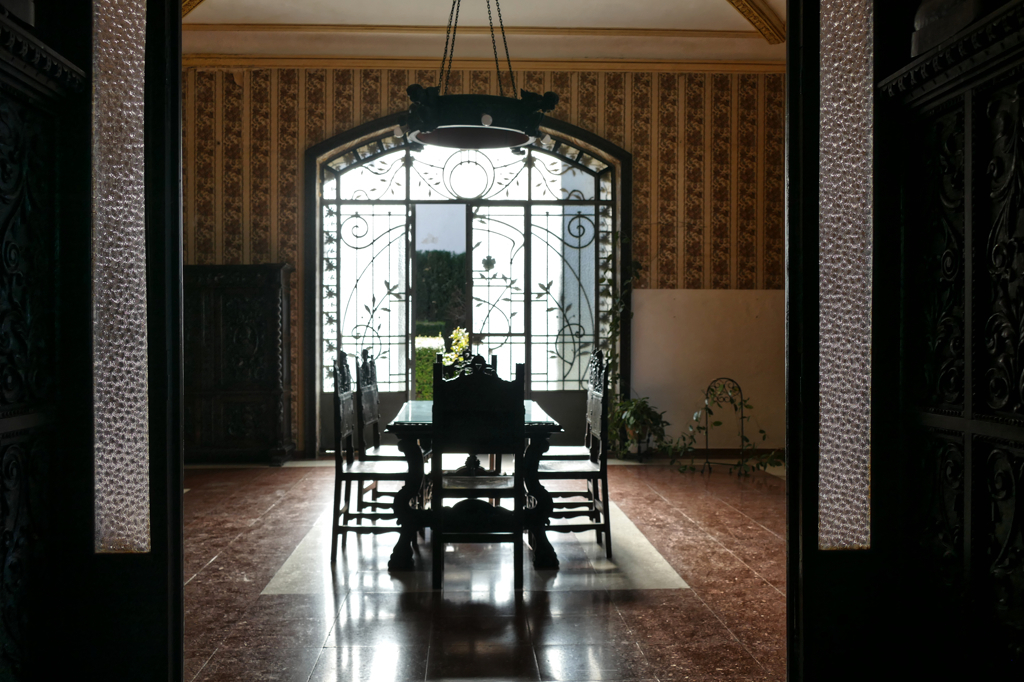
Today, it is a museum. It still is exquisitely furnished with walnut wood furniture, beautiful regional ceramics, and the fines tapestry from the 19th century.
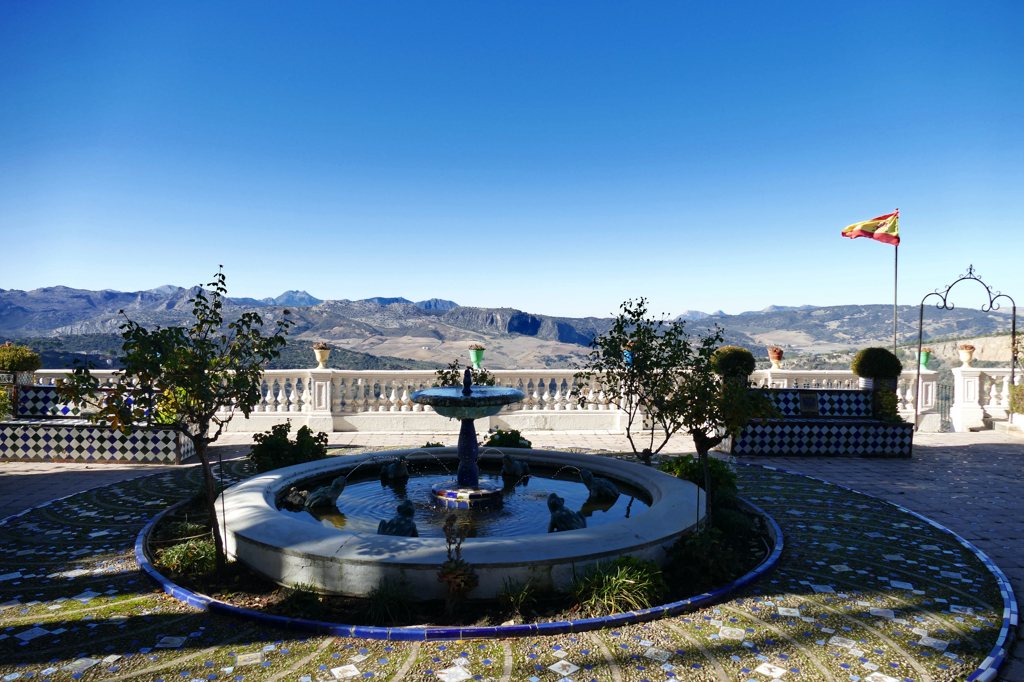
Simply breathtaking is the courtyard. Not only is it lavishly decorated. Its most amazing feature is the views of the endless Serranía de Ronda.
If you need a convenient spot for a short break during your visit to Ronda, the Casa Don Bosco’s lush’n’luxurious patio might be the perfect option.
The general admission fee is only 2.50 €uros. However, the Bono 8 Monumentos covers also Casa Don Bosco. You’ll find details about this pass in the Cash, Cards, and Deals section below.
La Casa del Rey Moro
The Casa del Rey Moro was built in the 14th century. Since Ronda occupied a strategic place in the struggle of the later Muslim kingdom of Granada against Castile, these were supposedly secret military structures. Wild legends like those of palaces and baths hidden in the fountains prevailed.
In 1912, the Duchess of Parcent commissioned the famous French landscape architect Jean Claude Nicolas Forestier to design the gardens. To this date, these hanging gardens on the edge of the Río Guadalevín have been preserved with all their original details.
Forestier designed them by mixing the Hispanic-Muslim arrangement with Western European horticulture. He planted different botanical species such as palm trees, laurel bushes, and cedar trees, oleander, and myrtle bushes. He added covered colonnades, colorful ceramic decoration, stairs, and floor slabs made of fired clay.
At this time, in January 2022, the building is undergoing restoration. Nevertheless, the water mine and the garden are open to visitors.
The general entrance fee is 7 €uros. The complex is open every day from October to April between 10 a.m. and 8 p.m. and from May till September till 9.30 p.m.
Mirador de los viajeros románticos and Convento de Santo Domingo
Walking from Ronda’s historic neighborhood towards the Puente Nuevo, you’ll pass a wall decorated with tiles. The center motif depicts a panoramic view of the city. On eleven plaques are quotes from famous visitors. Those so-called viajeros románticos, romantic travellers, expressed in tender words their love and admiration for Ronda.

But who were those romantic travellers? Well, the loss of natural refuges due to ruthless industrialization during the 18th and 19th centuries made mainly young upper-class people embark on a remarkable journey, the so-called Grand Tour. The humanistic heritage in Greece and Italy were the favorite destinations, but also the mountainous sceneries of Spain and other European countries. With passionate testimonies, they prompted more people to undertake these journeys.
Reading the quote from Washington Irving, even I can totally relate:
“There has been a storm tonight, wind and rain. I look out the window: the effect of the moonlight breaking the fog on the bridge is beautiful. White houses hang, which follow the course of the river at the bottom of the abyss … “
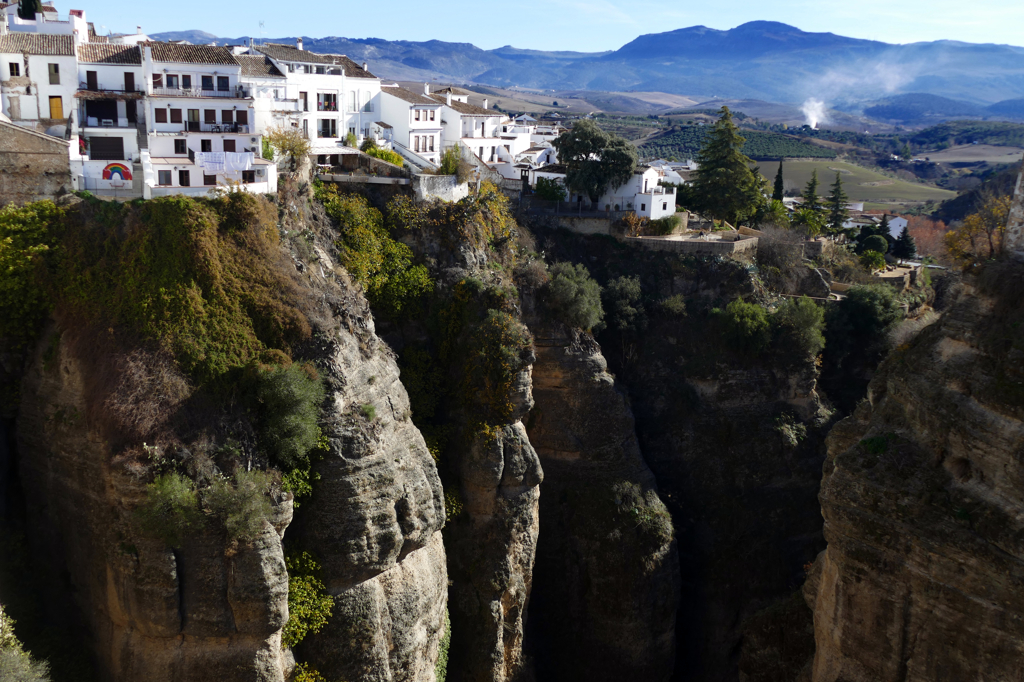
So, to get in the mood, don’t miss out on the Mirador de los viajeros románticos, the outlook on the right side of the wall. From there you have – once again – a spectacular and obviously very inspiring view of Ronda’s grand surroundings.
Convento de Santo Domingo
On the left side of the emblematic wall, however, is another building steeped in history. The Catholic Monarchs commissioned it about 500 years ago.
The convent consisted of several parts. Obviously, the church was the most important one. To this date, it stands to the southeast of the complex.
The Convento de Santo Domingo was actually the seat of the Court of the Inquisition. To be honest, that gives me the creeps.
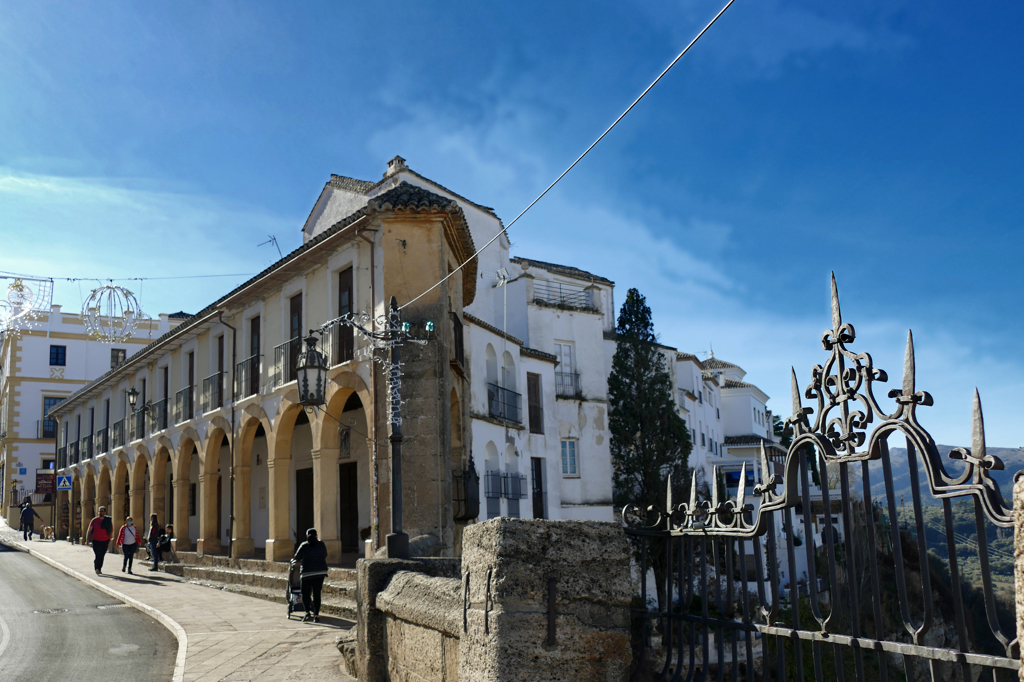
Today, the remodeled building houses Ronda’s convention center.
Nevertheless, touristy visits to the church and the outer cloister spaces are possible.
The opening hours are every day between 11 a.m. and 2 p.m. and in the afternoon from 4 p.m. to 8 p.m. except on Sundays. The entrance fee is only 1 €uro.
Mirador de Aldehuela
I even don’t know how many outlooks over the Serranía de Ronda and the Tajo gorge there are in the city. But I know that the Mirador de Aldehuela is an absolute highlight.
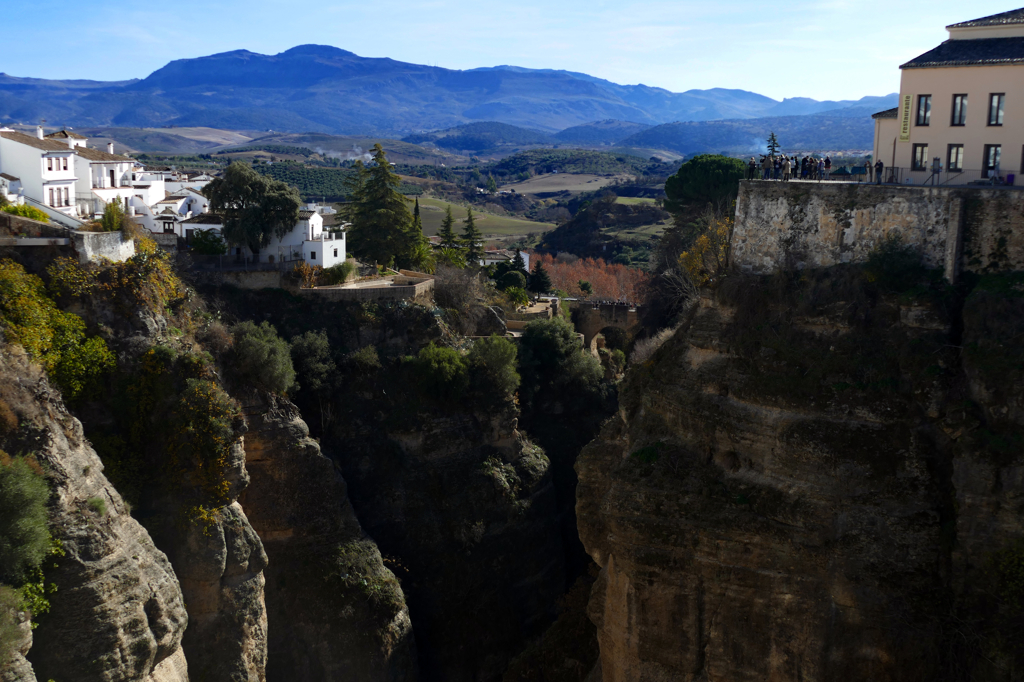
This viewpoint offers a fantastic vista of the impressive Puente Nuevo and the Tajo canyon below. If you can make it, come here early for the sunrise.
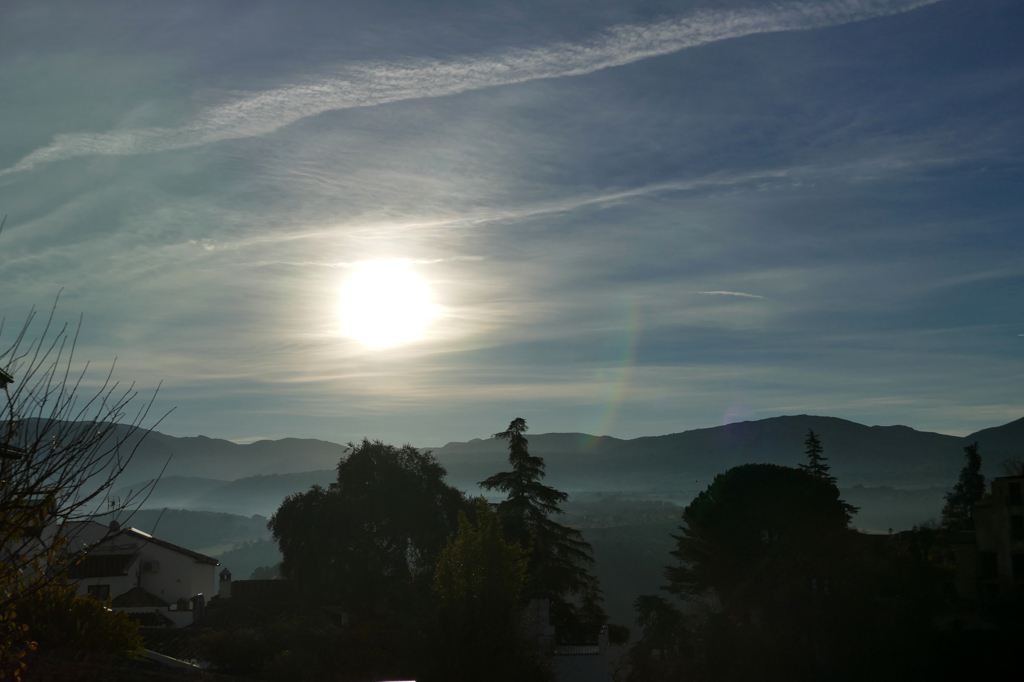
Although this viewpoint is definitely one of the most popular ones, there are many more spots around town from where you have overwhelming views of the Serranía de Ronda.
With its name Aldehuela, the city of Ronda pays tribute to the architect José Martín de Aldehuela. Not only did he build the iconic Puente Nuevo. He also created other important landmarks such as Ronda’s bullring Plaza de Toros and the aqueduct of San Telmo in Málaga.
Puente Nuevo and El Tajo de Ronda
Talking ’bout the Puente Nuevo: It is indisputably the most symbolic monument of Ronda. Believe it or not, with a height of 98 meters, the bridge that was constructed between 1751 and 1793, was the world’s highest bridge till 1839. Then, the title went to Pont de la Caille in France.

After a former bridge collapsed in 1741 and killed 50 people, the construction of a new bridge didn’t take place until 1751. To finance this building project, the Real Maestranza had to chip in with 15,000 Reales. Various master-builders were involved, whereby José Martín de Aldehuela was certainly the most prominent one.
The stone bridge has a central semicircular arch. The river runs through a smaller arch.
Enclosures in the bridge’s upper part were used as a prison. Subsequently, they housed an inn. Today, however, there is an information center telling about the bridge and the surroundings.
The visitors’ center is open daily from 10 a.m. to 6 p.m., however, on Saturday, there is a lunch break from 1.45 p.m. to 3 p.m., and on Sundays, they are closing at 3 p.m.
The general admission fee is 2 €uros. However, the Bono 8 Monumentos, as well as the Bono Túristico, cover also the museum. You’ll find details about these passes in the Cash, Cards, and Deals section below.
The Río Guadalevín formed the impressive gorge below the bridge. It is 50 meters wide and it has a large ridge that opens towards a circular ravine called La Caldera. Birds such as corvids, swifts, and pigeons find a perfect habitat in the shrubs covering the hollow.
Paseo de Kazunori Yamahuchi
If the romantic travellers had known how crazy the globalized world in 2022 would be.
Anyway, due to modern means of communication and transport, planet earth seems to be just a small ball without any significant distance – neither geographical nor cultural.
Hence, in 2013, a street behind the Puente Nuevo was named Paseo de Kazunori Yamauchi. I seem to be living under a rock since I had no idea who this – obviously Japanese – gentleman is.
Turns out he’s a professional car racing driver and video game inventor.
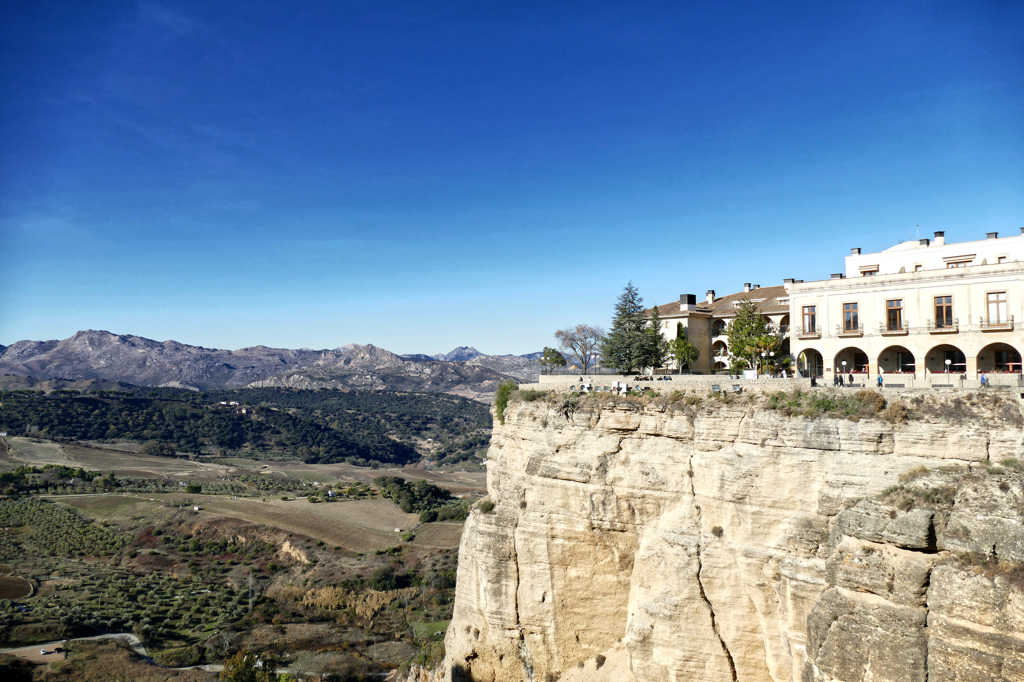
Since he included Ronda in a racing simulation from Gran Turismo, the municipal leaders honored him by giving a street his name.
Bullring of the Royal Cavalry of Ronda
The Plaza de Toros de Ronda is considered to be one of the oldest and most beautiful of its kind. The well-thought-out facility is a model for many bullrings in the world. As I mentioned above, the architect of the Puente Nuevo, José Martín de Aldehuela constructed also the bullring in the late 18th century.

The exterior of the arena is basically unadorned and windowless.
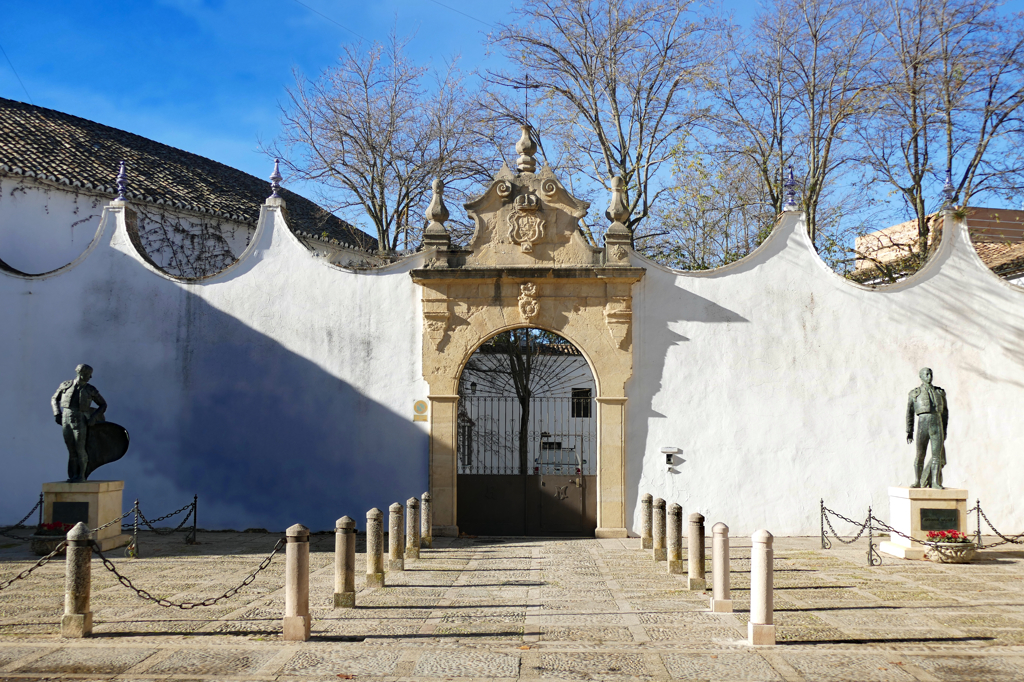
Inside, two all-around arcade galleries are arranged like floors. 136 Tuscan columns give the building a stately air. Each floor has five rows of seats. Up to 6,000 spectators can be accommodated.
Below the seats are the box cages for the waiting bulls and horses. They are operated from above, but aren’t visible to visitors.
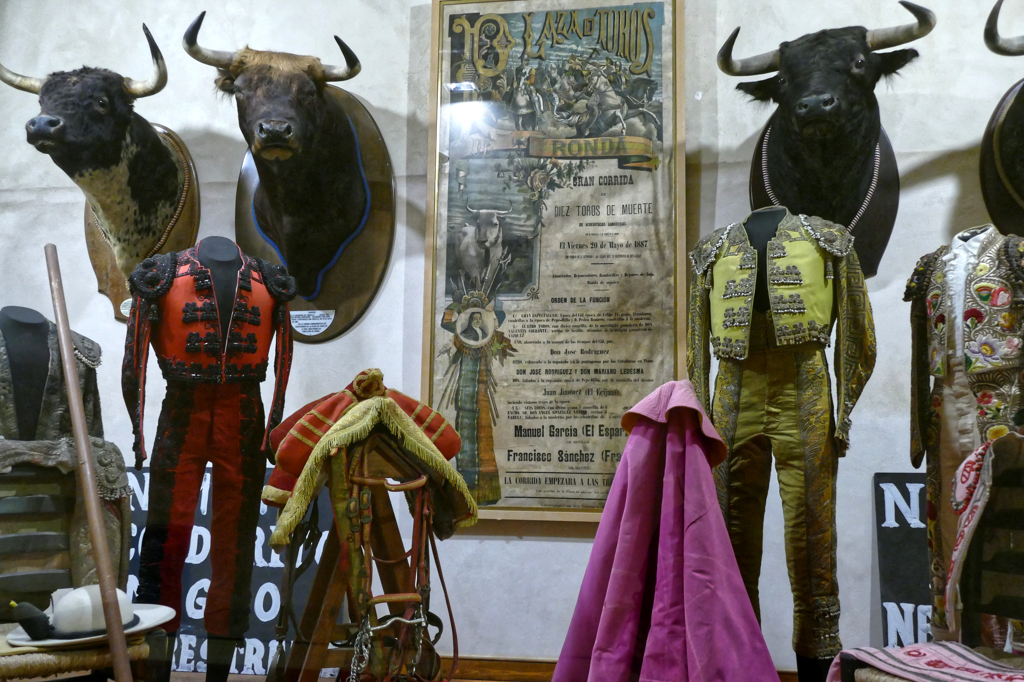
The complex also houses the riding arena and stables of the Real Maestranza de Caballería de Ronda, which is dedicated to classic dressage riding.
The Bullfighting Museum provides an overview of the history of bullfighting. On display are costumes of famous bullfighters, drawings, paintings, as well as numerous original posters.
The bullring is now only used for corridas during the Pedro Romero festival in September. On all other days, it is open to visitors from 10 a.m. till 8 p.m. The general entrance fee is 8 €uros.
Alameda del Tajo and Paseo De Los Ingleses
The best things in life are free. Although I would argue that this is not always the case, in Ronda it’s kind of true. The most beautiful parts are actually the historic buildings as well as the magnificent scenery all around. And one of the best places to see the city’s wild, wild west is the Alameda de Tajo.

This manicured park was laid out at the beginning of the 19th century. Various rare trees such as cedar from the Himalayas as well as many pines and mimosas are granting shade during hot summer days. Since it’s located right at the edge of a steep slope, it offers wonderful panoramic vistas.
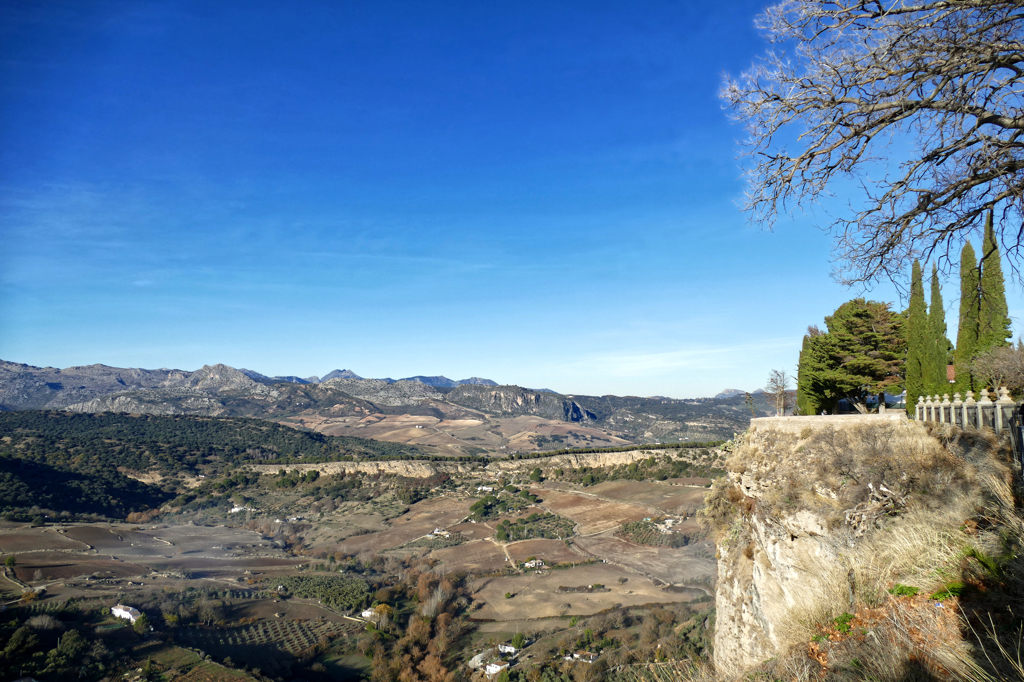
Whether you continue to the right on the Paseo de Los Ingleses or to the left on the Paseo Blas Infante, which leads to the bullring, you won’t get enough of the spectacular sceneries before your eyes and at your feet, I promise!
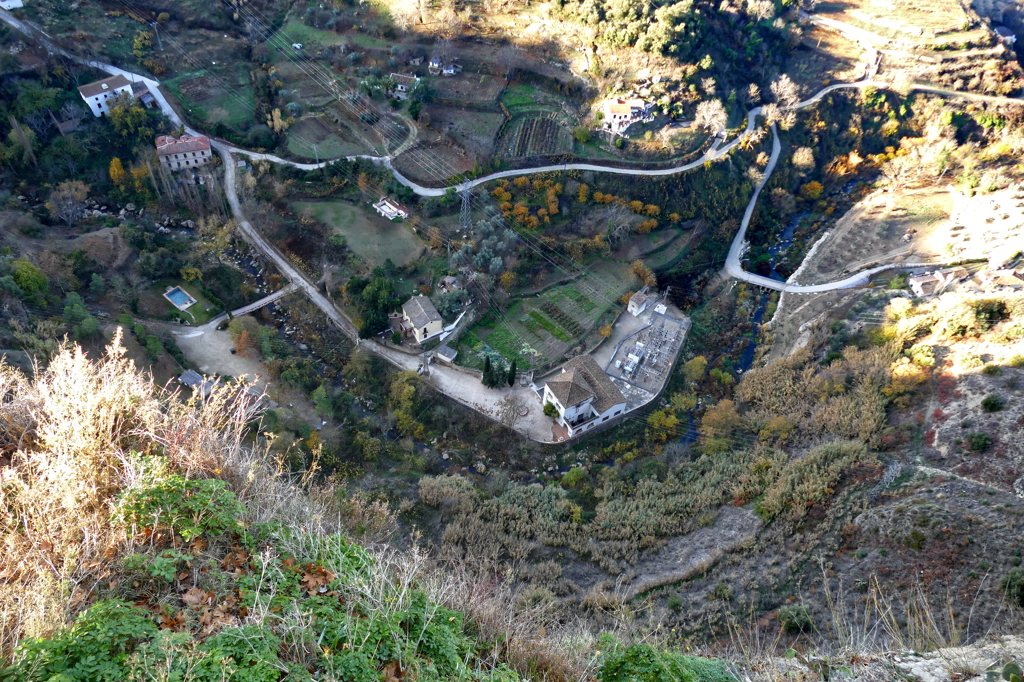
Plaza del Socorro
Some of the most important buildings from Ronda’s younger history are surrounding this pedestrian square.
The Parroquia de Nuestra Señora del Socorro on the eastern side is a relatively new house of worship. Its predecessor, stemming from the Reconquista, burned down in 1936.
Visitors to Ronda are often irritated by the semi-naked dude on the central Plaza del Socorro. This, ladies and gentlemen, is Señor Hercules taming two lions. This strong Roman is considered the founder of Andalusia.

To fully appreciate the importance of Hercule’s fountain and the history of the plaza, imagine the square full of cheering people as the father of Andalusian nationalism, Blas Infante, was standing on the balcony of the Circulo de Artistas and unfurled the flag in 1918.
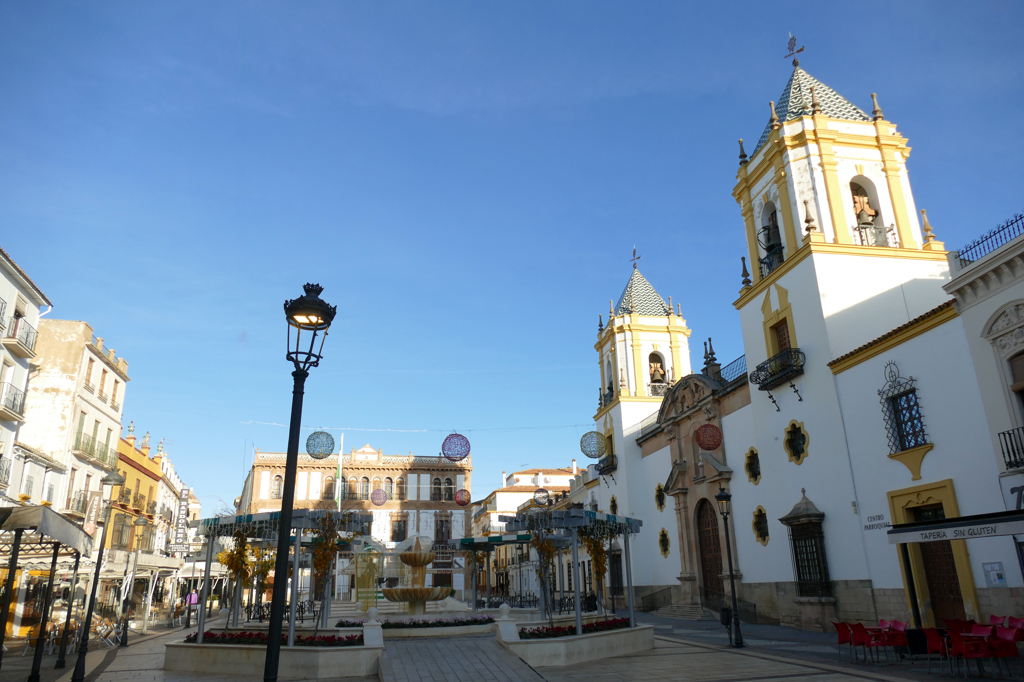
But his commitment made Blas Infante also a target. The fascists firing squad following Francisco Franco in the civil war, executed him and some of his comrades somewhere in the countryside.
However, to this date, the statues and the balcony are cherished as some of the most important symbols of Andalusian patrimony.
Practical Information
How to Get to Ronda And Around
Ronda is situated rather secluded and about 750 meters above sea level. Nevertheless, since it’s such a popular tourist destination, it can be easily accessed by public transport.
There are some train connections to some cities such as Algeciras, Córdoba, and even Madrid. Those, however, are few.

https://www.stay22.com/embed/68e78097f499a18fc495f58e
Obviously, you can reach Ronda also by car, for instance in about 1.5 hours from Málaga and Seville and in 2 hours from Córdoba. Nevertheless, keep in mind that parking options are quite limited. There is chargeable underground parking at Plaza del Socorro.
Ronda is a small town, easily navigable on foot.
Once you get to Ronda, you will probably explore walking. However, there are city buses at the incredibly low price of 1 €uro per trip. But keep in mind that the driver doesn’t accept bills larger than 5 €uros.
Where to Stay
Ronda is a very popular tourist spot, hence, choices of accommodation are plenty. According to my experience, at the Casa Duende del Tajo*, you get a million-dollar view for the price of a bunk bed in a dorm. Although they are in Ronda’s prime location, the guesthouse as such is rather simple. My room was rather small and I had to share the bathrooms with other guests. Just sayin’. Because I would book there again any time.
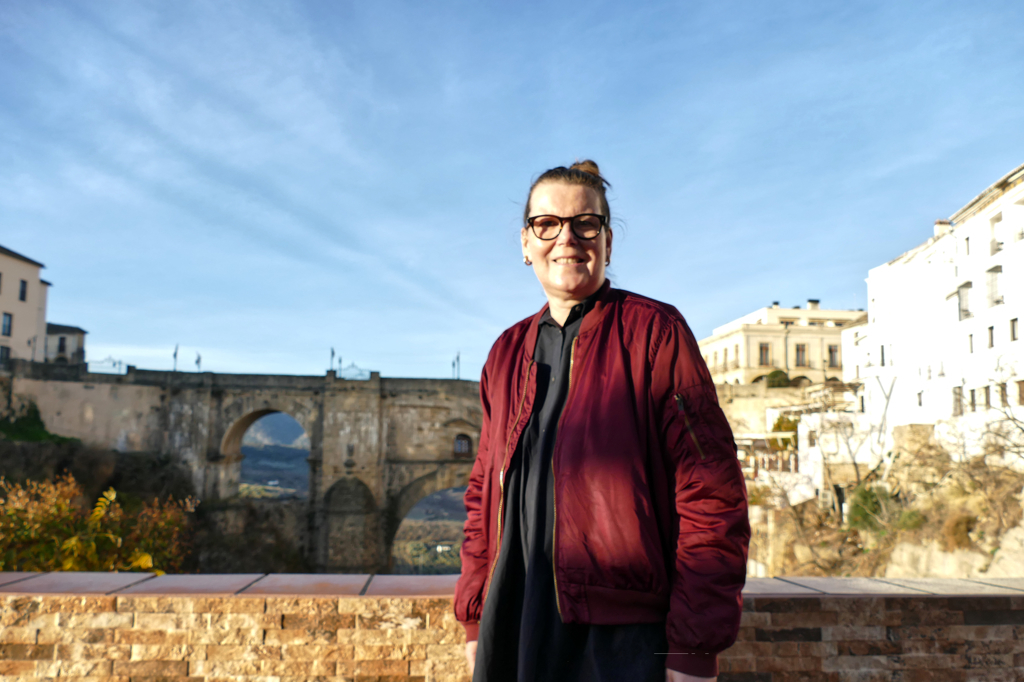
Nevertheless, on this map, you can choose convenient lodging options* according to the price and the location in Ronda. And don’t be sad if you don’t get a room with a view: Visiting Ronda, you’ll enjoy fantastic views all along, hence, you do not necessarily need an additional view from your window:
What to Eat
Again – since Ronda is quite touristy, there are many dining options. My tip: If it is a small place with older people sitting inside around the bar, it’s usually a good sign.
Like anywhere else in Spain, you can enjoy a glass of beer or wine with some tapas, varied small snacks.
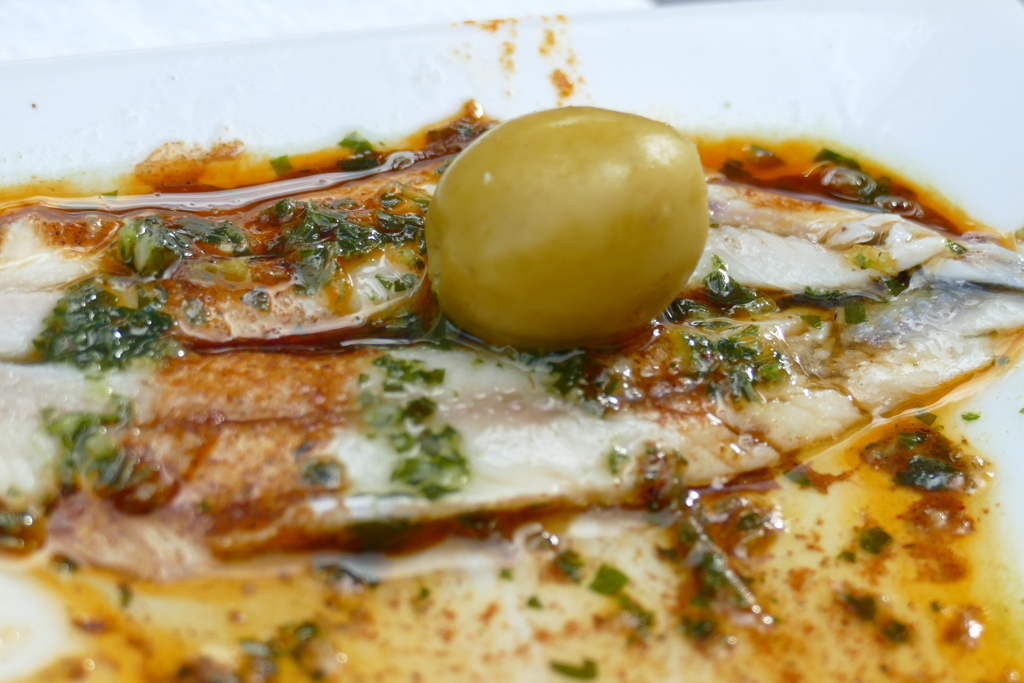
If you’re not at the biggest tourist trap, you’ll get some small tapas with your drink – at least olives, peanuts, or something else to nibble on. But you can also order a ración, hence, a serving, or also media ración, a half-sized serving.
Tapas can be slices of serrano ham, diced cheese, olives, small sandwiches, a blob of ensalada rusa, potatoes salad with mayonnaise – you name it.
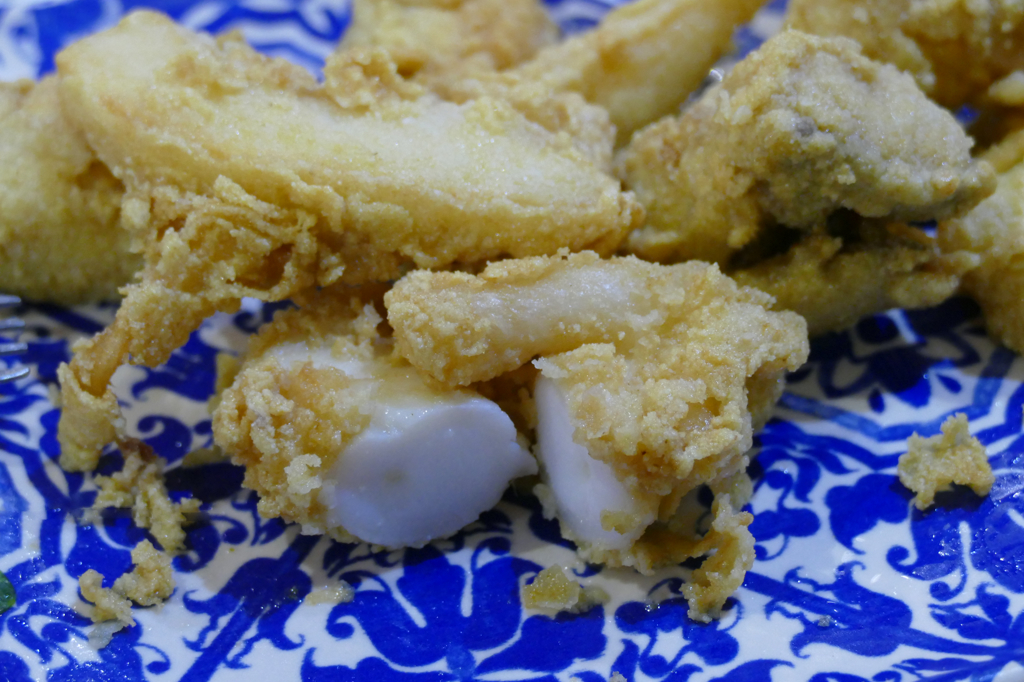
If you are really hungry, the menú del día might do. It’s usually a three-course meal that you can combine to your liking from different starter, main course, and dessert options. Often, water and even wine are included.
My favorite places in Ronda were:
– the Café Colon on Calle Jerez 13 for breakfast
– Los Capeas on Calle Virgen de la Paz 38 for lunch
– La Casapuerta on Carrera Espinel 43 for drinks and tapas as a starter and eventually, a ración of fried squid for dinner
You’ll find all three places marked on the map below.
Note:
Although I had a wonderful time in Spain and apart from the bus drivers, everyone treated me nicely, solo travel had a big downside.
Most of the time, Spaniards are going out to dine in large groups. Whether it’s families or their posse, they come in groups of at least eight and occupy large tables.
Obviously, restaurants are prepared for that so mainly at the old, established eateries, it’s not easy to get a table when you are a solo traveller. Often, they have maybe one small table if any at all. Therefore, they are not always able – and happy – to accommodate you.
Don’t take it personally.
There are so many bars and restaurants in Spain, I’m sure you’ll find another place that’s at least as lovely as the one you wanted.
Cash, Cards, and Deals
Until now, 20 European countries replaced their former local currency with the €uro starting in 2002. Obviously, Spain is one of them. The exchange rate is 1 US$ = 0.84 EUR as of October 2025. However, you can check today’s conversion rate on this page.
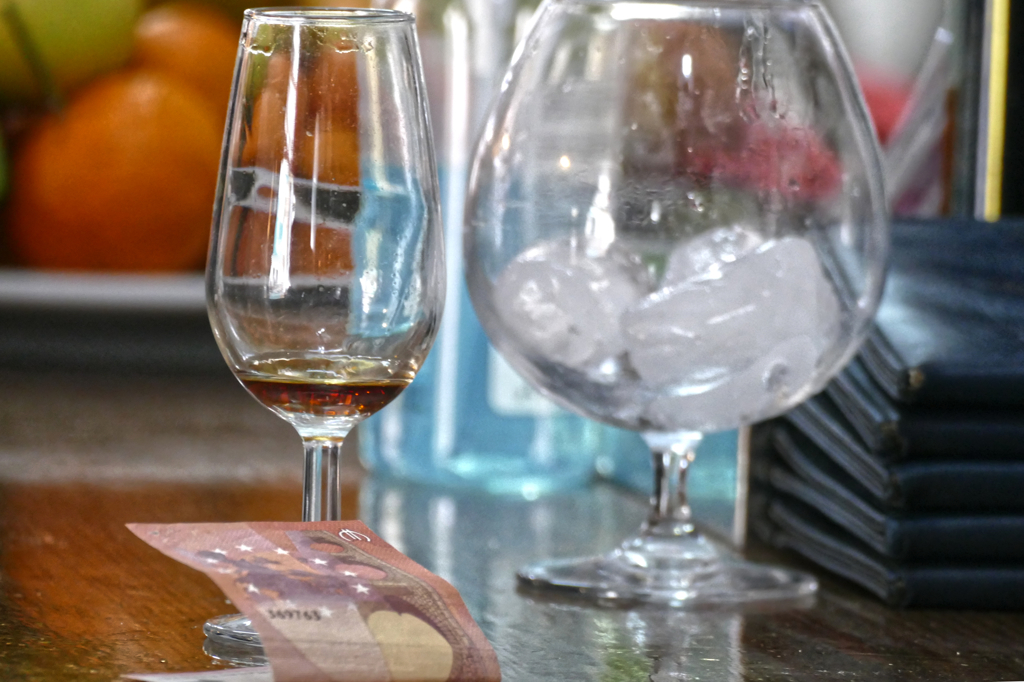
You can pay with credit cards basically everywhere – as a matter of fact, due to the pandemic, most businesses prefer contactless paying by credit card for safety and hygienic reasons.
Depending on how you want to spend your time in Ronda, you might be interested in one of these passes that give you access to the most important landmarks and museums at a reduced price:
Bono Túristico
With this pass, you have access to the Infocenter of the Puente Viejo, the Baños Árabes, the Palacio de Mondragón, and the Archeological Museum as well as the Casa del Gigante. As the general price is 12 €uros, you only save time during the high season since the individual entrance fees add up to exactly the same sum.
Bono 8 Monumentos
However, when you obtain the Bono 8 Monumentos, you also save money since you pay 20 €uros for entrance fees that would set you back 26.50 €uros when bought individually. Nevertheless, you might want to ask yourself if you are really interested in visiting all eight landmarks that are included. Either way, since I’ve quoted each individual entrance fee above, you can easily do the maths of what works best for you.
The Infocenter of the Puente Viejo, the Baños Árabes, the Palacio de Mondragón and the Archeological Museum, the Casa del Gigante, the Casa Don Bosco, the Santo Domingo Convent as well as the museum Joaquín Peinado and Lara are included.
You can obtain your pass online or at the Municipal Tourist Office, at the Infocenter of the Puente Viejo, at the Casa del Gigante, or the Baños Árabes.
Connection and Communication
Since June 2017, no roaming charges apply within the EU with a European mobile phone contract. This applies in all 27 countries of the European Union as well as in Iceland, Liechtenstein, and Norway and to all contracts.
If European roaming is not available, you can connect to the internet without any issue at basically every museum, eatery, café, and, of course, hotel.
If you insist on being online 24/7, you can get a SIM card, obviously. The cheapest one would be Lycamobile while Orange Tu Mundo has the widest coverage.
In Spain, they use plug types C and F. Their voltage is 230 V and the frequency 50 Hz. Whereby, as nowadays, all these chargers have integrated adapters, in general, the voltage and frequency don’t really matter.
By the way, you’ll find this information and many more comprehensive travel tips in my post World’s Most Complete Travel Information – an indispensable globetrotter-classic.
Alone No More
Especially if you don’t have much time and do not want to spend the night in Ronda, you can join an organized day trip for instance from Seville or Málaga:
Map
This map should help you to find all the wonderful places I’m introducing in this post.
Ronda was only one of many amazing places I visited during my road trip through Andalusia. To read about the others, go to the main post and take your pick! There, you’ll also find further valuable general information that will make your own trip much smoother and more enjoyable.
Pinnable Pictures
If you choose to pin this post for later, please use one of these pictures:


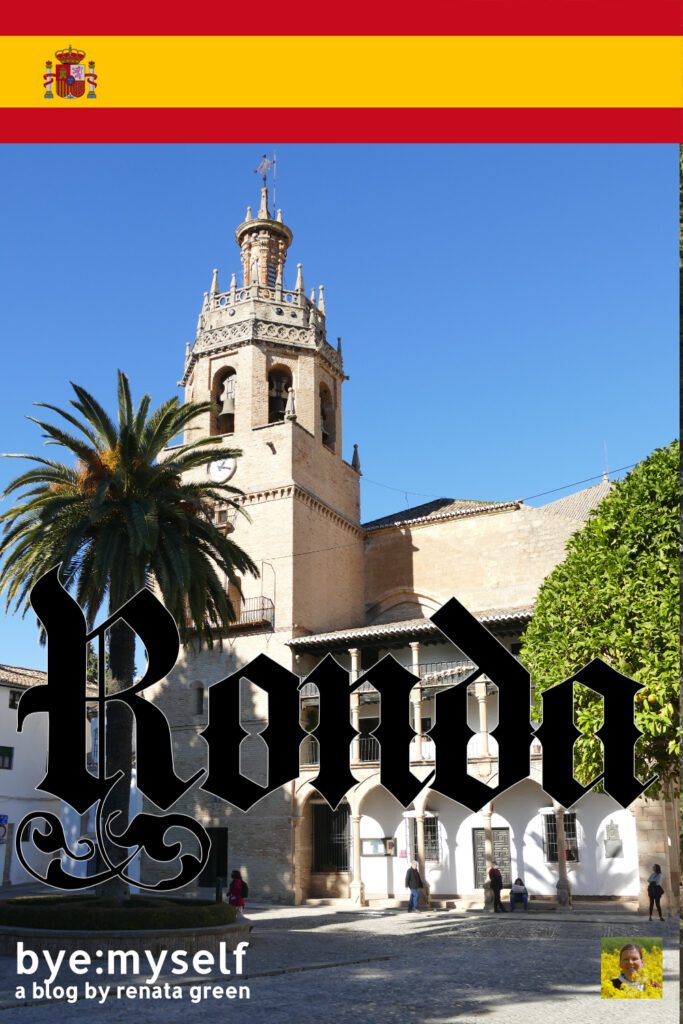
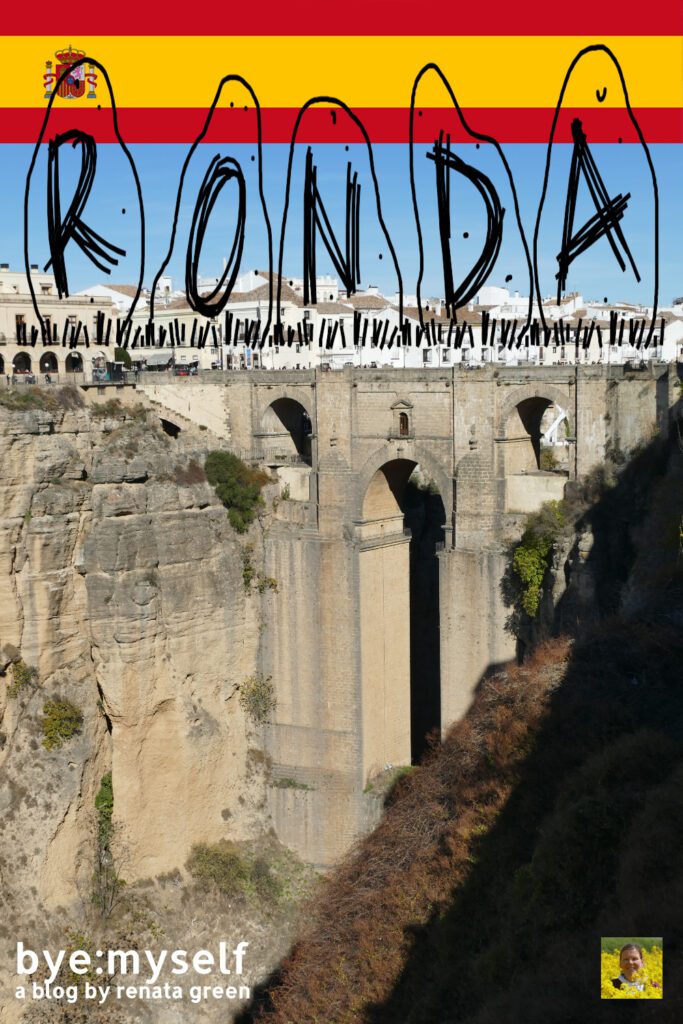
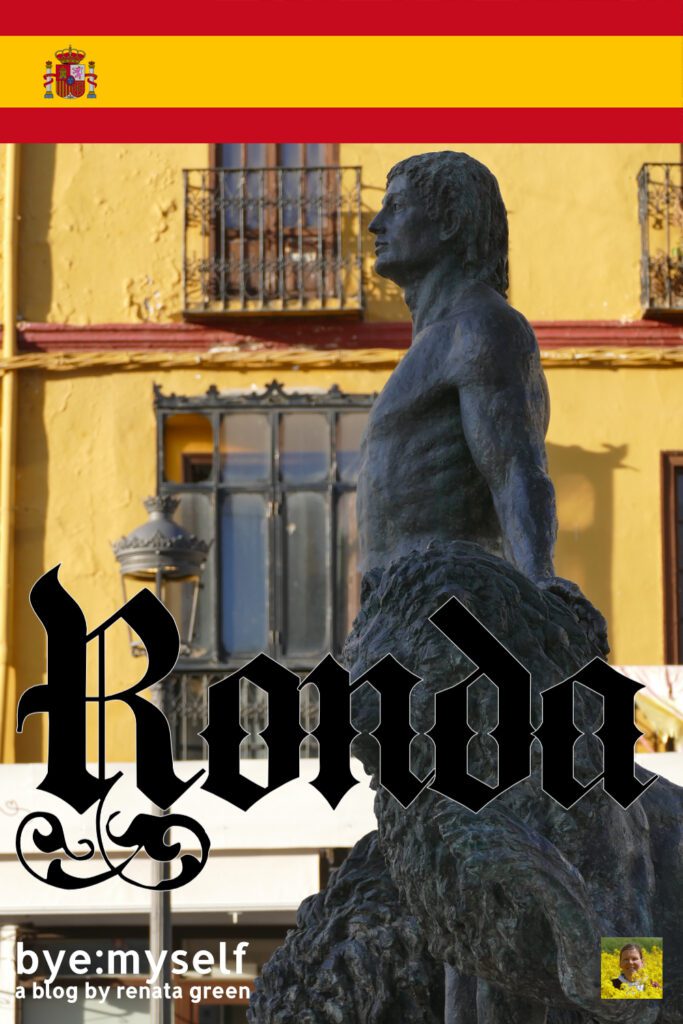

Note: I’m completing, editing, and updating this post regularly – last in October 2025.
Did You Enjoy This Post? Then You Might Like Also These:
Guide to CORDOBA – the Moorish Center of Andalusia
Day Trip to AGÜIMES and SANTA BRIGIDA – going to the heights of beauty
ARTENARA and TEJEDA – a Day Trip to Gran Canaria’s Highest and Most Beautiful Villages
FORNALUTX – the Most Delightful Village in the Tramuntana Mountains
Guide to MALAGA – How to Enjoy the Ease of Being at the Hometown of Pablo Picasso
A Visit to the Colonia Güell – Where Eusebi Güell Created His Universe
Day Trip to the Albufera Nature Reserve Outside Valencia
PLAYA de COFETE – thirteen kilometers of paradise
* This is an affiliate link. Hence, If you book through this page, not only do you get the best deal. I also get a small commission that helps me run this blog. Thank you so much for supporting me!
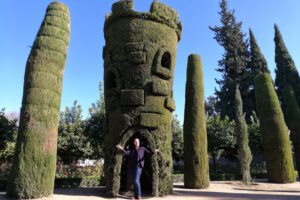
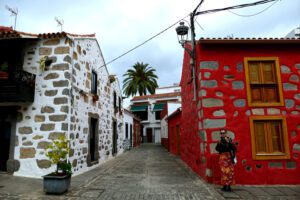
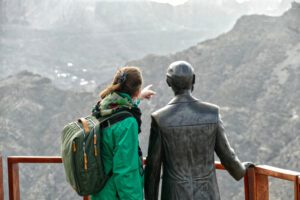
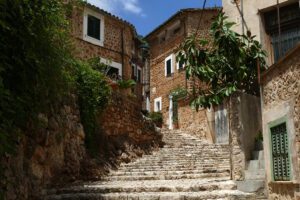
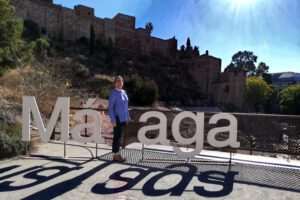

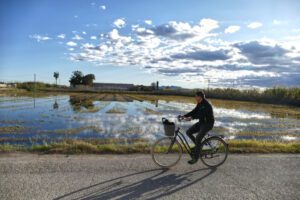
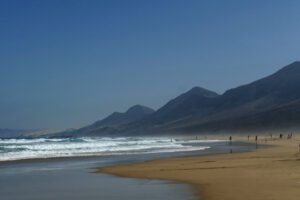
I was extremely pleased to discover this page. I want to to thank you for ones time due to this wonderful read!! I definitely appreciated every part of it and I have you bookmarked to look at new information on your web site.
Ronda is most definitely a fascinating place 🙂
It’s a fascinating and detailed guide to Rondo. This is one of my favorite villages in Andalusia. I love the iconic Puente Nuevo! Cuenca Gardens, with its stepped terraces, offers excellent views as well.
Andalucia really is just an amazing place, definitely my favorite region of Spain!! I saw Ronda on a few articles and itineraries for Andalucia, but I didn’t have time to visit. What a loss, it looks beautiful and very unique. Love how it’s right at the edge of the canyon. Will have to re-visit Spain and make it here one day.
Not only does this place have an interesting history, but also has been visited by so many famous artists. The view of the bridge is breathtaking!
Thank you so much, I visited here as a teenager with family but could not remember where it was we went to. I just remembered the gorge and bridge being so beautiful and the old buildings. Great pictures too
How fun! However, I’m afraid that teenagers appreciate glorious landscapes less than old folks like me 😉
Ronda really looks like somewhere that would only exist in the movies! I cannot believe how great your view was from your room!
Right?!? I was just blown away. The glorious view was such a stark contrast to the simple room 😀
This post brought back great memories of our day trip to the wonderful white town of Ronda from our stay in Marbella. We too went by bus. We only had one day so did not see near what you did. Next time we will have to plan. I am sure there is lots to see in the area.
The view from your room is absolutely amazing! I have never considered visiting Ronda but this guide is so inspiring! Whenever I am to visit I will be sure to stay at the same – Casa Duende del Tajo. Nothing can beat that view!
Very well said, Polly 😉
There are so many beautiful places in Ronda to visit! Hoping to visit these beautiful places someday when the pandemic is over. I miss traveling so much!
I knew nothing about Ronda but after reading this informative post, it looks like somewhere we would love to visit one day. I think my husband, as a photographer, would really enjoy it. Thanks for sharing!
These bridges are stunning- As a photographer I would love to visit this beautiful beautiful place. I’ve never even heard of Ronda before
Yes, it was great having sooo many gorgeous motifs in one small spot 🙂
Although I’ve never been to Ronda, I LOVE how you started the post out with a song reference. Hope to visit Southern Spain soon!
Haha, I appreciate it a lot when readers get my little…references 😉
so beautiful! It definitely is a white gem. the architecture is breathtaking. there is something special is mountain location also.
Wow, the new bridge is stunning and it’s worth going there just for that view. On top of that there are so many beautiful sites and great food, I am packing my bags right now.
Yes, you’re right: Already the sight of the bridge made the entire trip worth the while 🙂
how beautiful! wanna visit it so badly! the photos are amazing
I love the wide-open space with lots of nature. And also love the history and the historical houses. I love history and would love to visit them”
Andalusia is packed with history….and beauty 😉
The view from the Jardines of Cuenca, Mirador de Aldehuela, and Baños Árabes are stunning! When I eventually decide to visit Ronda, I’m not sure which one I’ll go to first, but I’m sure I’ll go to all of them! This is fantastic!
I had only one day in Ronda and managed to see all three of them. Nevertheless, next time, I’d stay at least for two days. 🙂
Gosh! I was amazed in the photos so what more in person. Appreciate you sharing these 🙂
Yes, as you stand before this stone bridge, it’s a whole different level than seeing it in a photo – it’s just…wow! 😀
This is interesting. It’s good to learn about new places and explore places like these. Thank you for sharing!
Wow, these places were so beautiful even at night! Thanks for listing this useful guide! I would love to visit these places someday.
Yes, I was quite overwhelmed by Ronda’s beauty!